Looking to plan a Yellowstone 3-day itinerary and wondering how to best spend your time? You’re in the right place!
Planning a trip to Yellowstone National Park is exciting!
But, it can also be overwhelming – especially if you’re trying to pack your visit into a few short days, over a long weekend, or traveling with kids.
That’s where I can help! I love planning roadtrips to National Parks (and really anywhere, if we’re being honest) so before our visit I spent countless hours researching the best Yellowstone has to offer before visiting with my family of four on our own trip.
After making a few mistakes – like underestimating the need to acclimate to the difference in elevation or how long it would take to get from one spot to another – I quickly discovered the ideal itinerary to make the most of Yellowstone in 3 days.
To save you time and keep you from making the same mistakes, I compiled this detailed Yellowstone National Park Itinerary combining my extensive research with our personal experience.
Whether you’re visiting with kids, hoping for incredible wildlife sightings, or just looking to soak in the stunning scenery and geothermal activity, Yellowstone has something for everyone.
From the best viewpoint to see the Grand Prismatic Spring (the Overlook along Fairy Falls Trail), which accommodations are most centrally located (Canyon Village & Campground), and the unexpected sunset stop that turned out to be one of my favorites (West Thumb Geyser Basin), you’re sure to find plenty of adventures to fill your itinerary here.
By the end of this post, you’ll know where to stay, which things are must do’s, and how to organize your days to avoid wasting precious time in the car. Let’s get started!
🔉 This is the best audio tour to learn more about the park during your visit! Our kids even loved it and would remind us if we forgot to turn it on.
Yellowstone National Park Itinerary at a Glance
Overview of Yellowstone 3 Day Itinerary
In a hurry? You’ll find the entire 3 day itinerary in detail below, but here’s a quick rundown along with the most convenient lodging options to get you started:
- Day 1: Roosevelt Arch, Boiling River/Gardiner River, Mammoth Hot Springs, Golden Gate Canyon Drive, Roaring Mountain, The Hoodoos, Sheepeater Cliff, and Lamar Valley.
- Best lodging options:
- Head closer to Hayden Valley and stay at Canyon Village (try Canyon Lodge & Cabins or Canyon Campground) since you’ll be getting up early for sunrise on Day 2.
- You could also consider staying just outside the North Entrance in Gardiner at the Yellowstone Gateway Inn. Still, your wake-up will be much earlier to catch wildlife activity at sunrise.
- Best lodging options:
- Day 2: Hayden Valley, Yellowstone Lake, Dragon’s Mouth Springs & Mud Volcano, Grand Canyon of the Yellowstone, and Dunraven Pass
- Best lodging option:
- Canyon Lodge & Cabins or Canyon Campground
- Best lodging option:
- Day 3: Norris Geyser Basin, Artist Paintpot, Fountain Paint Pots, Midway Geyser Basin, Old Faithful Geyser Area, and West Thumb Geyser Basin.
- Best lodging options:
- One of the hotels at the Old Faithful Geyser Area (Old Faithful Inn, Old Faithful Snow Lodge, or Old Faithful Lodge) or Grant Village.
- You could also consider staying just outside the West Entrance at Kelly Inn.
3 Day Yellowstone National Park Map Overview
Yellowstone National Park is MASSIVE, so having a well-planned itinerary can save you a ton of driving time. Grouping together your Yellowstone activities in different regions of the park and staying nearby is the most efficient way to see as much as possible.
You can see how this works in the Roadtrippers map below. And if you’re curious, here’s how I use Roadtrippers to plan our trips.
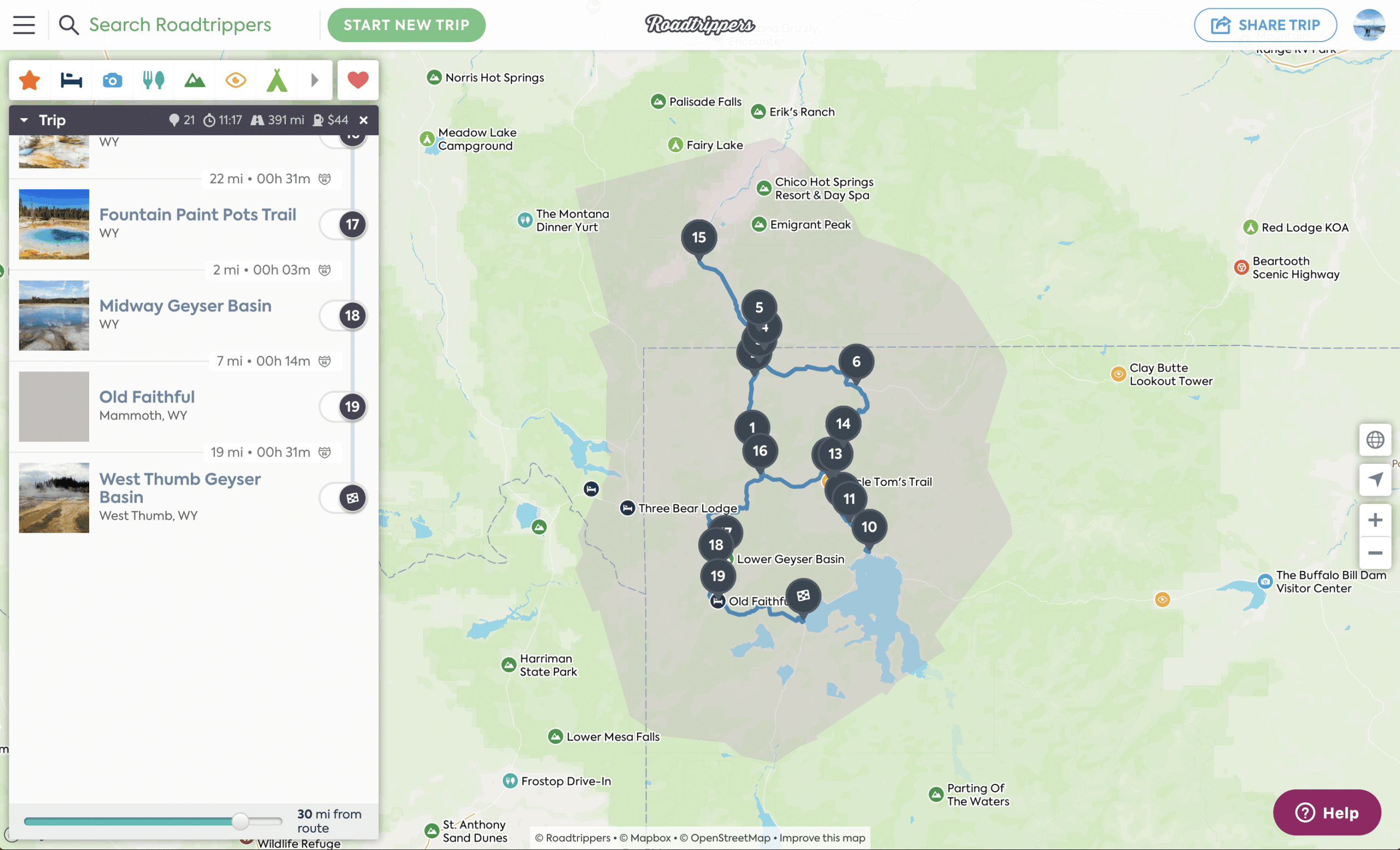
What to Know Before Visiting Yellowstone National Park
When visiting any National Park, there are a few things you’ll want to know before you go to make planning easier and to make things smooth during your stay.
Below you’ll find some of the most important tips and things to know when visiting Yellowstone.
Where to Stay in Yellowstone
When planning a multi-day trip, it’s super important to consider your lodging options in Yellowstone carefully. You can stay in hotels, snag a cabin, or stay at campgrounds throughout the park.
But, because the park is enormous, you’ll want to minimize your drive time to see as much as possible.
To do this, I suggest splitting your accommodations up into two separate locations OR staying as centrally located as possible. If you prefer to stay in one location for your entire visit, Canyon Village & Campground is the most centrally located.
Note
Lodging and campgrounds in Yellowstone book up well in advance. I suggest booking your accommodations 9-12 months in advance to make sure you get the location you want.
Keep in mind that even if you stay centrally located at Canyon Village, you will still have to account for longer drive time on certain days. For example, driving from Canyon Campground to Old Faithful will still take you over an hour.
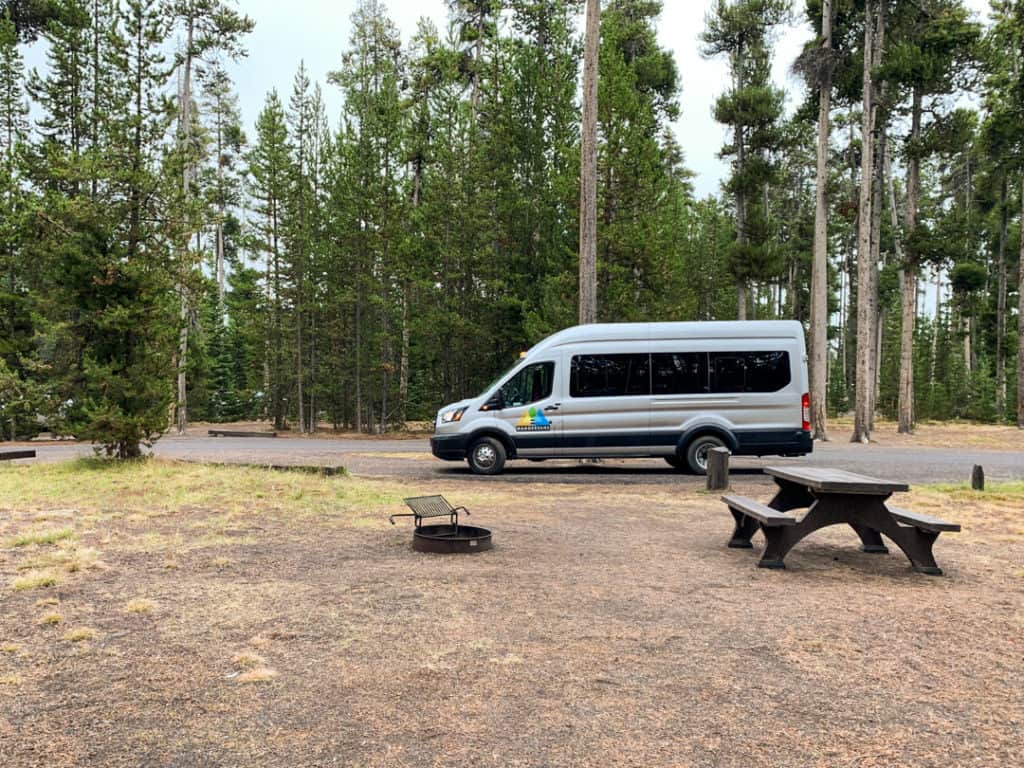
We received a campervan rental from Wandervans for this trip. All opinions are honest and completely our own.
We decided on getting a campervan from Wandervans, and it was honestly the best decision we could have made. It made our trip so much easier since we were able to split our time between two different campgrounds with ease. One of the best things about it was that we could eat our meals whenever and wherever we wanted. It was so convenient and really made our trip so much more enjoyable!
When to Visit Yellowstone
While Yellowstone can be incredible in any season (and I’m dying to go back in winter!), you’ll want to aim for summer or early fall for this itinerary. That’s the sweet spot to avoid winter road closures and ensure you experience all of the park’s highlights.
Fees and Accessing the Park
Reservations are not required to visit Yellowstone National Park, but you will need to pay a fee to enter. You have a few options to purchase your pass.
- America the Beautiful Pass: If you plan to visit multiple National Parks, National Forests, or BLM land during the year, this is your best value at $80/vehicle for an entire year to all NPS Sites and Federal Recreation Lands.
- Yellowstone Annual Pass: $70/vehicle for a year gives you access to Yellowstone only
- 7-day Pass: If you’re only visiting Yellowstone and won’t visit any other National Parks or Federal Recreation Sites, you can save a little money with this pass for $35/vehicle.
To access Yellowstone, you’ll need to enter through one of the park’s five entrances:
- North Entrance near Gardiner, Montana
- Northeast Entrance near Cooke City, Montana
- South Entrance, located north of Grand Teton National Park (add it to your itinerary if you have time!)
- East Entrance near Cody, Wyoming
- West Entrance near West Yellowstone, Montana
Important Updates for 2024
For 2024, there are a few additional things to know when booking your accommodations and planning your itinerary.
First, there are twelve campgrounds total in Yellowstone. As of 2024, they all take reservations (though some are for a limited number of sites).
However, three are closed for the season: Norris, Pebble Creek, and Tower Fall. In addition, Mammoth Campground’s opening dates are to be determined.
Note: For the most up-to-date information on properties maintained by Yellowstone National Park Lodges, click here.
Second, all the park roads are expected to open this year. Most will open in April or May. However, the opening date for Beartooth Highway is to be determined. In addition, please check the NPS website here for the most up-to-date information on closures and road maintenance.
Day 1 in Yellowstone: The Upper Loop and Mammoth Hot Springs Area
On our first day in Yellowstone, we hit a bit of a snag with a late start after my husband wasn’t acclimating very well to the change in altitude from home base. Things can happen, even when you make plans, so flexibility is key!
In case you didn’t know, the elevation in Yellowstone ranges from around 5,000 feet to over 11,000 feet. Many roads, campgrounds, and attractions sit between 6,000-9,000 feet above sea level, which can be an adjustment if you’re not used to it.
(This is what happened to hubs. We live around 200 feet above sea level, and climbing straight up to 8,000-9,000 feet didn’t sit well.)
For your first day especially, I highly suggest drinking plenty of water and keeping physical activities to a minimum to give your body time to adjust. Severe altitude sickness is rare in Yellowstone, but knowing what to look for and taking it easy the first day is a good idea.
Our recommended stops are below, but if you’re pressed for time, Yellowstone Lake could wait. However, Yellowstone Lake really does impress, so if you miss it on your first day, do your best to circle back to it on your final day before heading out of the park.
You can see the overview of our Day 1 route here.
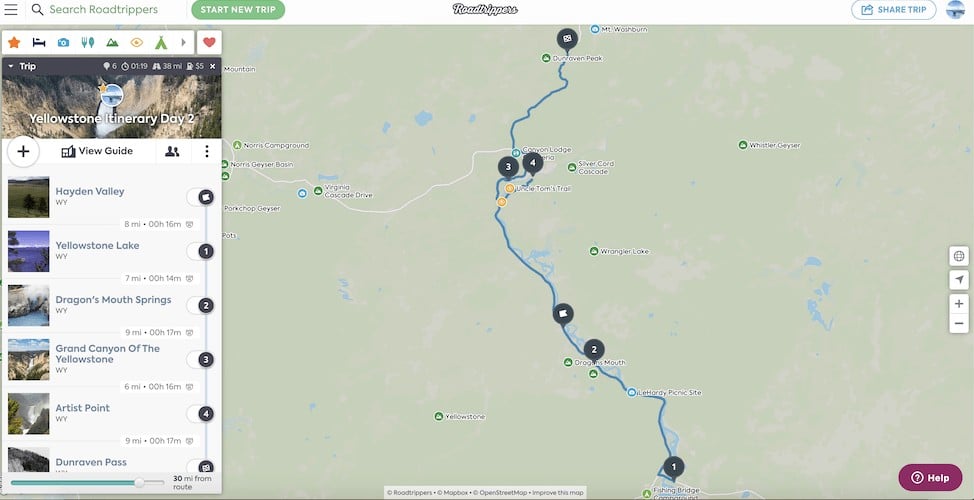
📍Get Roadtrippers Plus with $5 Off
Sheepeater Cliff
Sheepeater Cliff is just a quick stop, but it is worth it for the stunning columnar basalt formations.
Keep your eyes peeled for yellow-bellied marmots, too! We didn’t see any, but they like to hang out in this area.
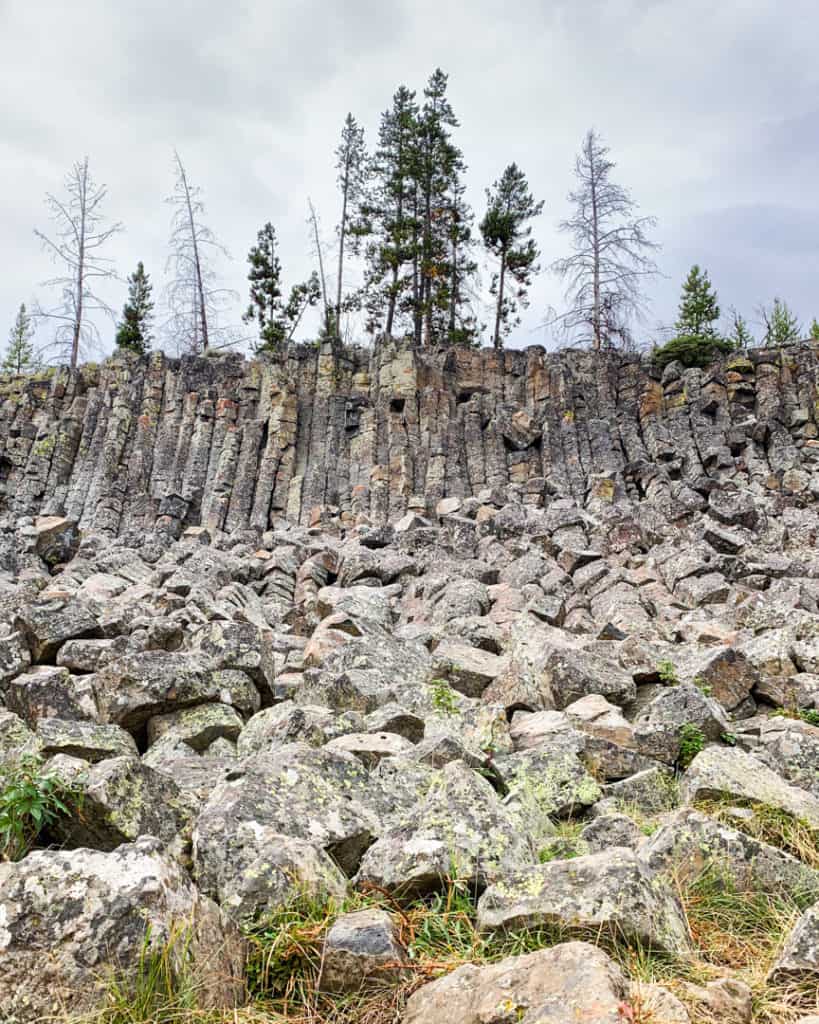
The Hoodoos
Take advantage of the pullout for the Hoodoos! It’s a quick but memorable one-way drive that takes you through these massive boulders that broke off from Terrace Mountain and tumbled down to their current location.
Roaring Mountain
Roaring Mountain is another relatively short stop on your route where you’ll see fumaroles releasing steam and gas – and listen carefully! Roaring Mountain got its name from the roaring sound that could be heard from miles away in the early 1900s. However, we heard more of a hiss than a roar during our visit.
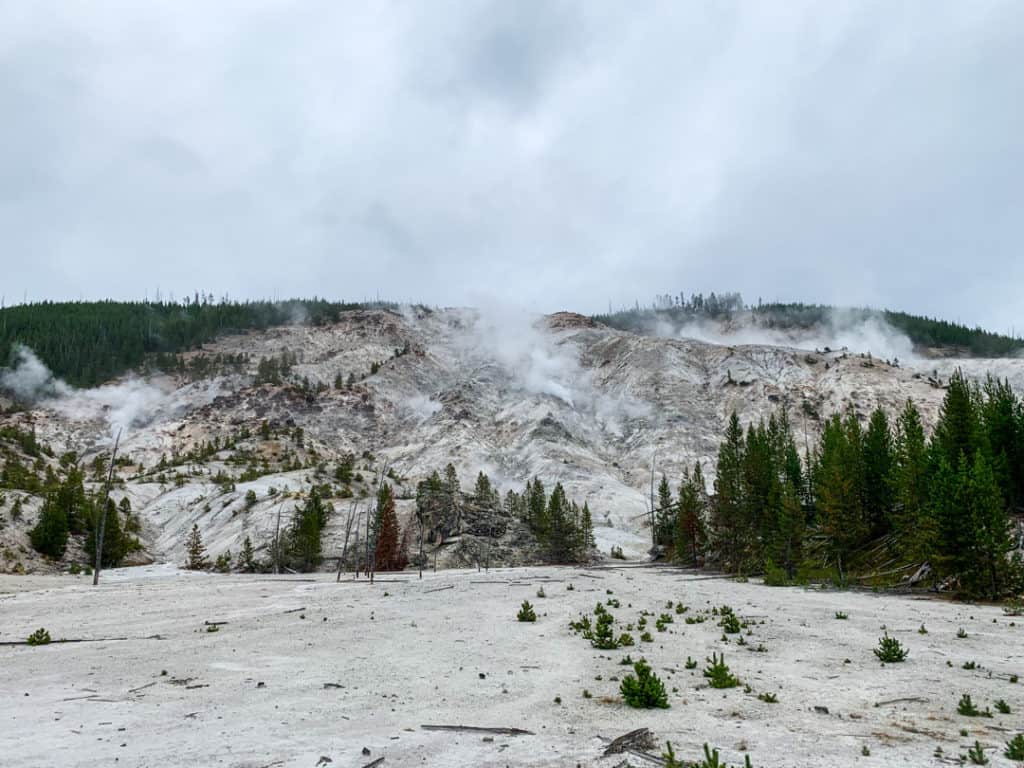
Golden Gate Drive
Hands down, Golden Gate Drive is one of my favorite views from our entire trip! The drive can be a bit unnerving if you’re not a fan of heights or narrow, winding roads, but if you’re up for it, it’s totally worth it. The lichen attached to these rock walls makes them appear golden as you wind through the canyon. Pictures honestly don’t do justice to the incredible scale of this canyon. You really have to see this one to appreciate it.
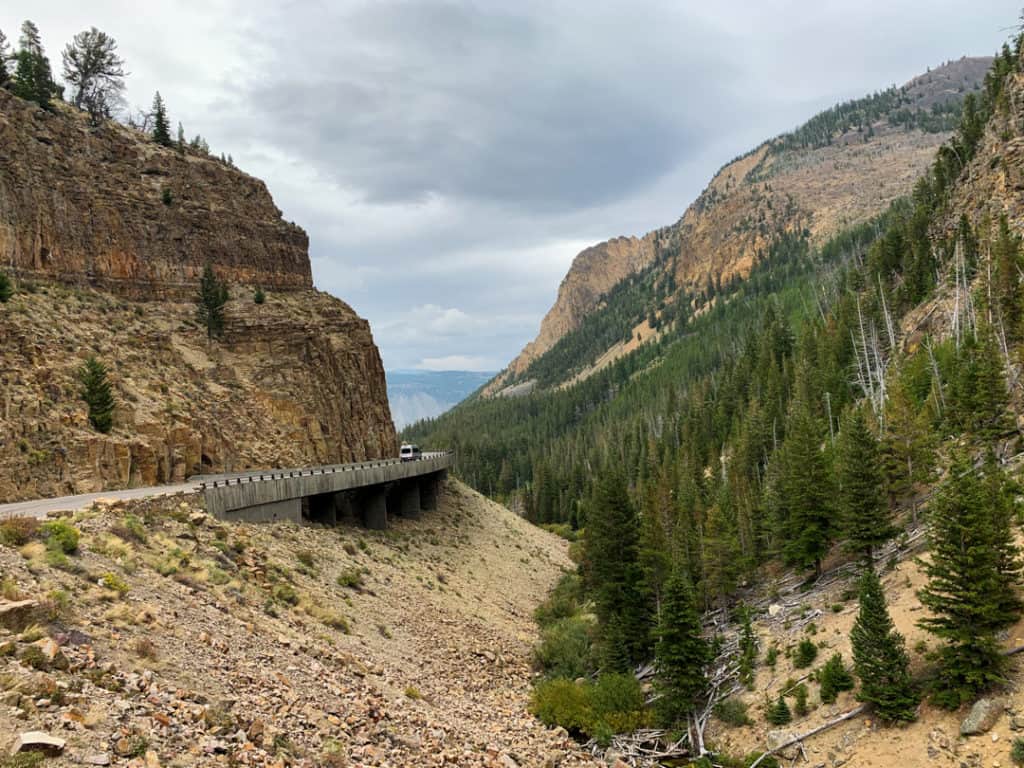
Mammoth Hot Springs
Mammoth Hot Springs is a geothermal wonderland with unique terraces that create a cascading series of natural pools. Take your time wandering through the various places to explore both on foot and by car before moving on to your next stop.
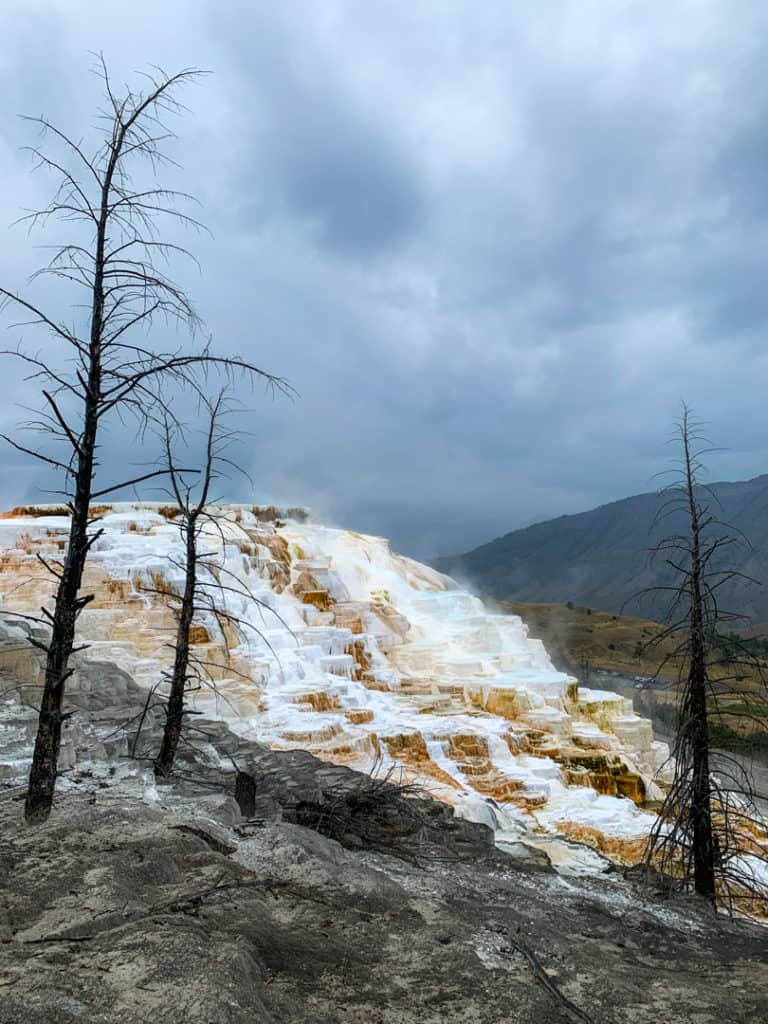
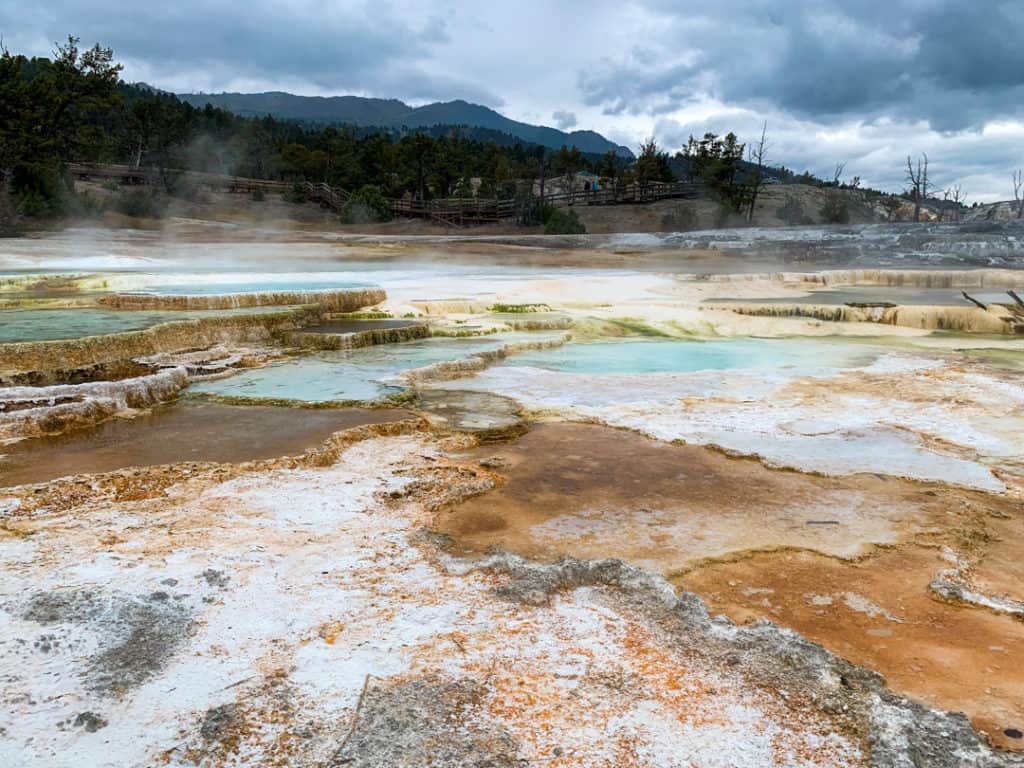
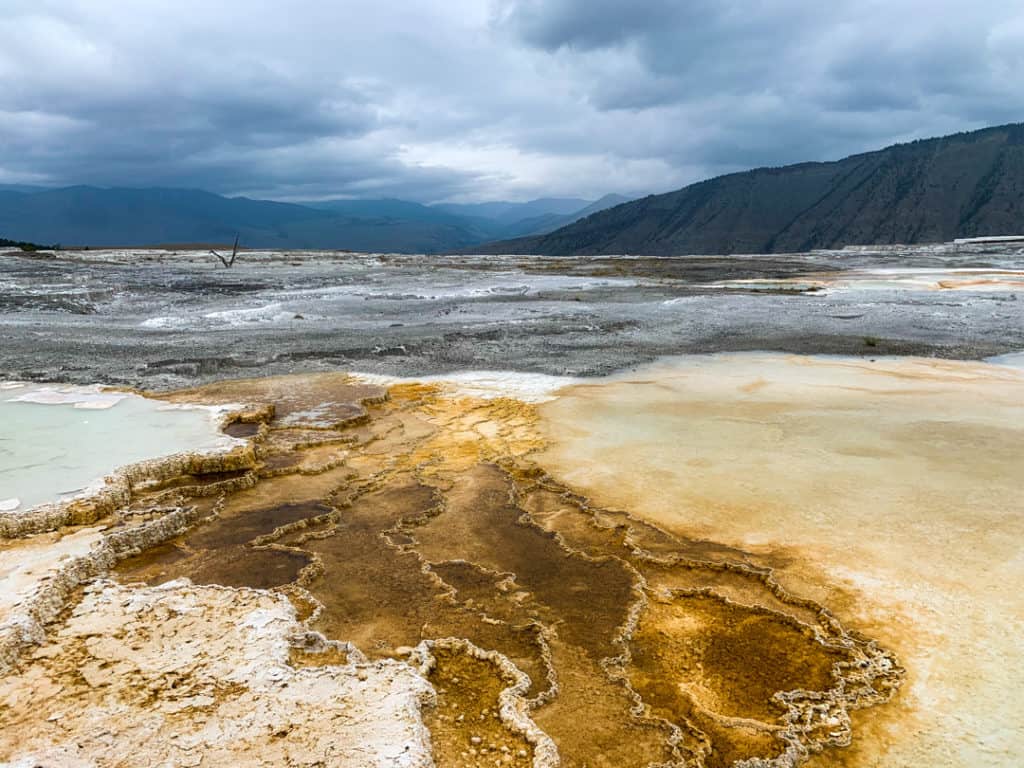
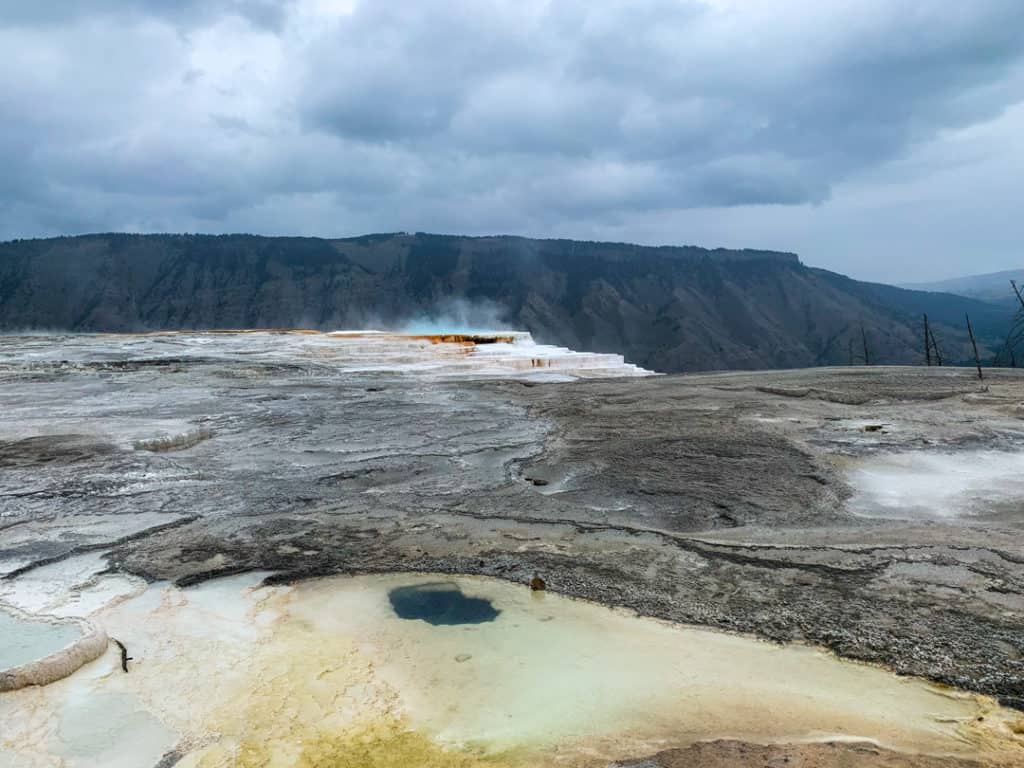
Boiling River/Gardiner River
In the past, Boiling River was one of the only hot springs in the park that was safe to swim and soak in. Unfortunately, massive flooding in 2022 really shook things up, making it a no-go for swimming here currently.
However, if you’re in a campervan or have food with you, continue past Boiling River and find a pulloff along the road to make dinner like we did! It was the perfect spot to relax, watch the hawks, and listen to the rushing river.
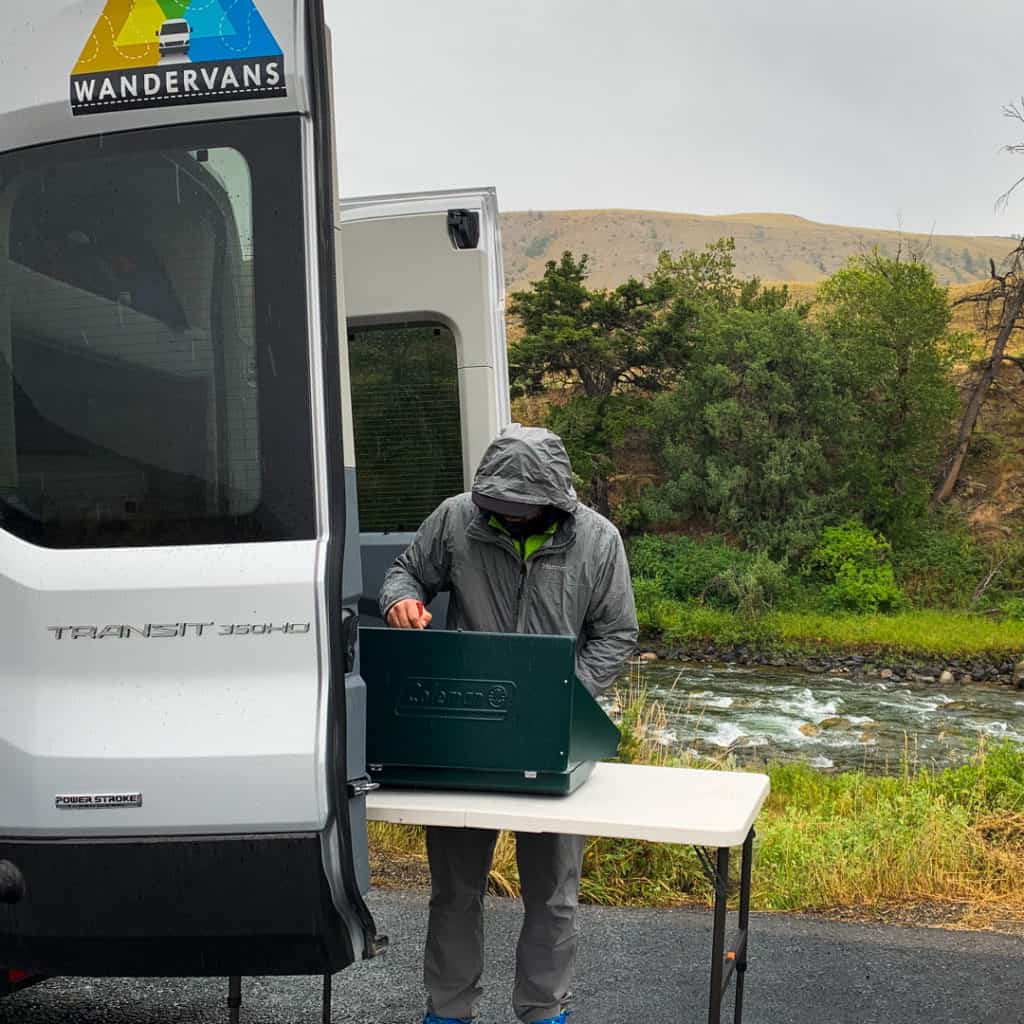
Roosevelt Arch
The iconic gateway of the Roosevelt Arch, marked with “For the Benefit and Enjoyment of the People,” sets the tone for the awe-inspiring nature of Yellowstone. This arch, constructed in 1903, serves as a historic entrance to the park, making an impressive statement as you enter via the North Entrance of the park.
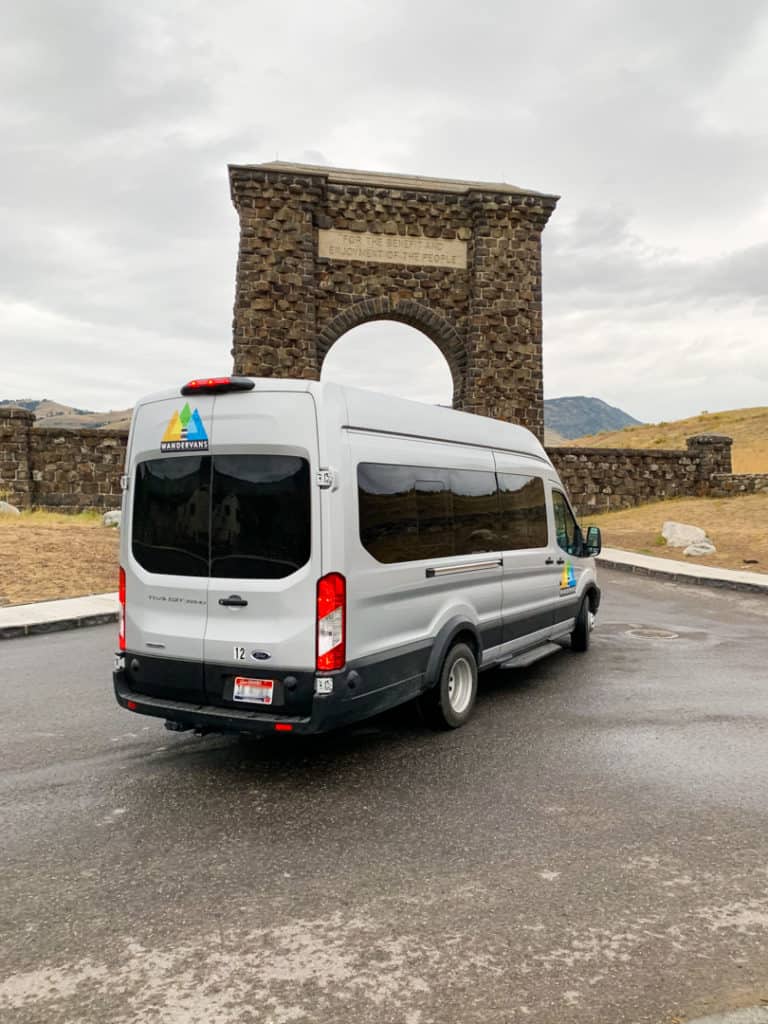
Lamar Valley
During our visit to Yellowstone, we spotted a large variety of wildlife: pronghorn antelope, great blue heron, peregrine falcons, squirrels, bison, coyotes, chipmunks, ducks, Canadian geese, elk, swans, eagles, hawks, moose, mule deer, and bears!
Many of those animals were spotted in Lamar Valley, one of the best places to see wildlife in the park. For the best chance of sightings, plan your visit today at dusk. Drive through or find a pull-off to sit patiently and wait for movement.
Tip
Don’t forget your binoculars and camera! Here are the binoculars and the camera I currently have and love.
This is also typically one of the ideal places to see one of the resident wolf packs in Yellowstone. Unfortunately, we didn’t have luck, but I’m crossing my fingers for you!
Tip
If you have time later in your trip, dawn is another excellent time to see wildlife in Lamar Valley!
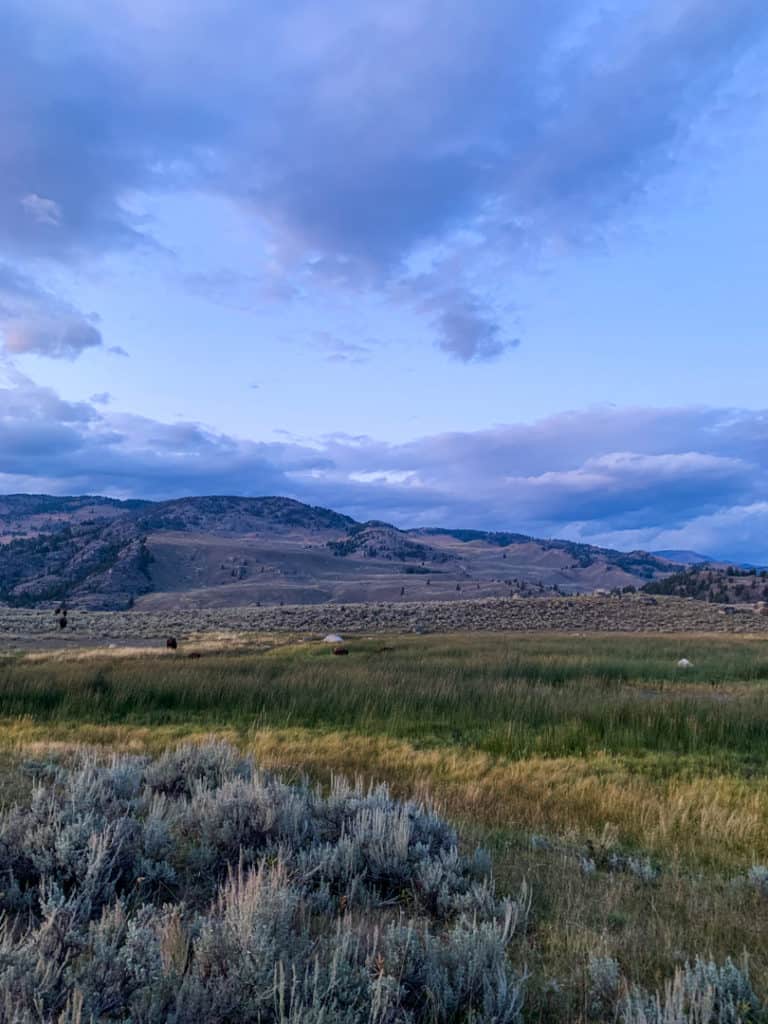
Day 2 in Yellowstone: Hayden Valley, The Grand Canyon of the Yellowstone, and Dunraven Pass
Rise and shine! Day 2 starts bright and early to increase your chances of catching those early morning wildlife sightings.
See the overview map of Day 2 here
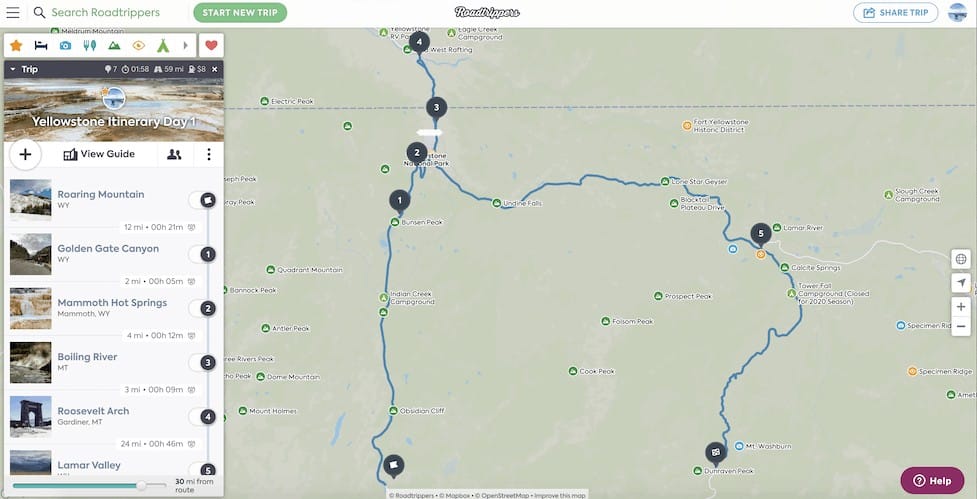
📍Get Roadtrippers Plus with $5 Off
Hayden Valley
Hayden Valley at sunrise is one of the best places to find wildlife. Known for abundant animal sightings, it’s worth getting up early to watch the valley come to life. Though you can drive through the valley, you may find better luck spotting animals by finding a spot to sit still and scan the valley for movement.
Tip: Remember your binoculars and camera!
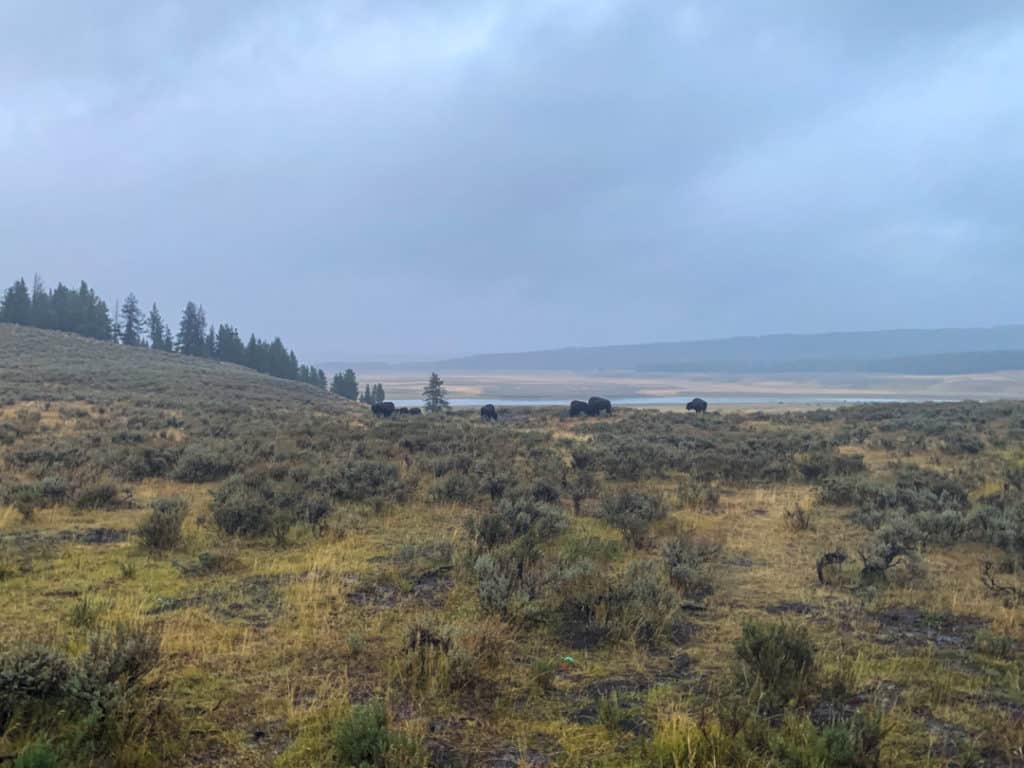
Yellowstone Lake
Whether you’re looking to fish, get out on a boat, or just soak in the stunning views, Yellowstone Lake gives you another unique perspective of the park. If you want to stretch your legs a bit, a couple options to try are the Pelican Creek Nature Trail or Storm Point Loop.
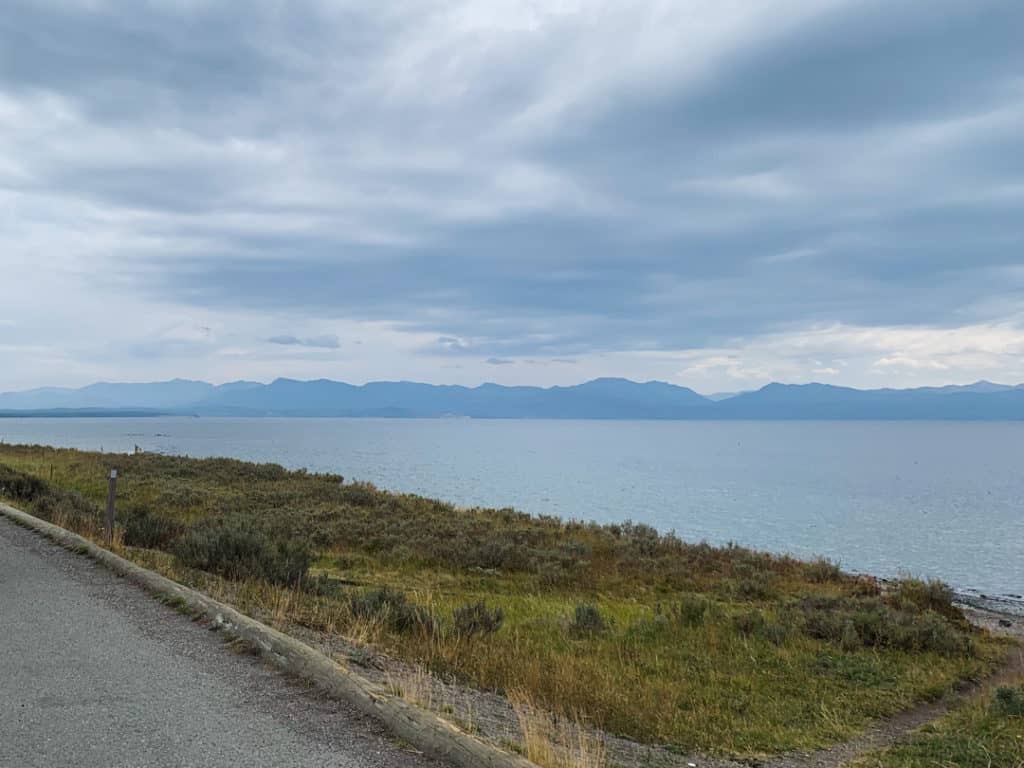
Dragon’s Mouth Springs, Mud Volcano, and Sulfur Cauldron
The Mud Volcano Area is sure to bring a mix of awe and scrunched-up noses. Though the bubbling mud and steaming “Dragon’s Mouth” are fascinating, our oldest was NOT a fan of the sulfur smell. 🤣
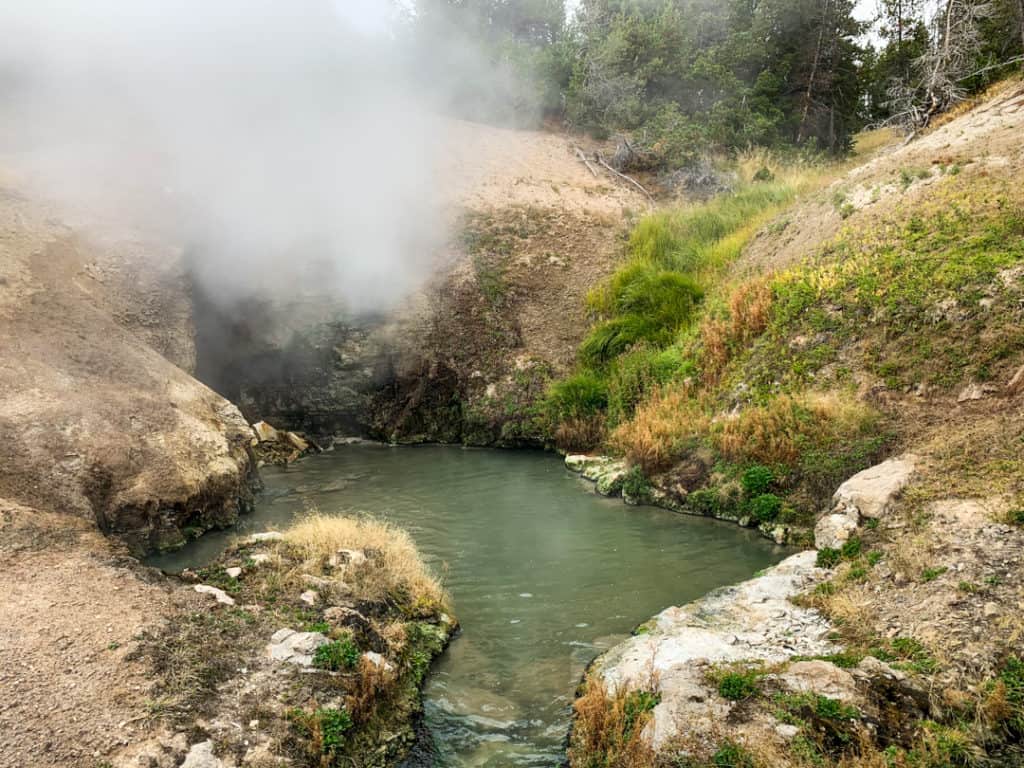
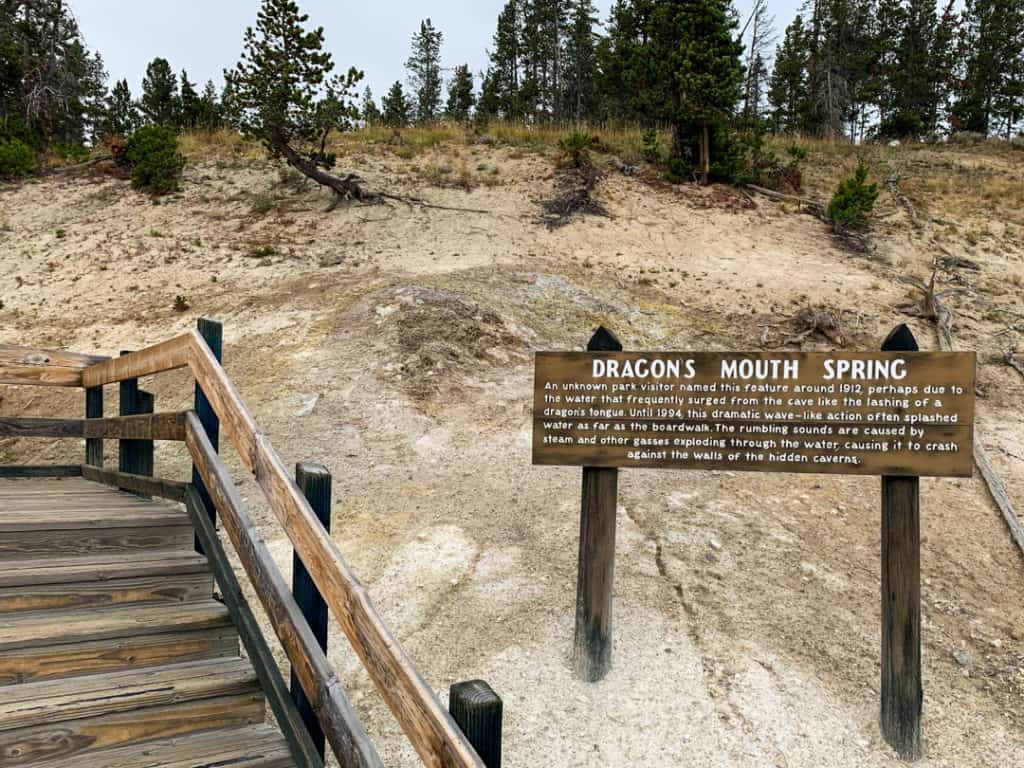
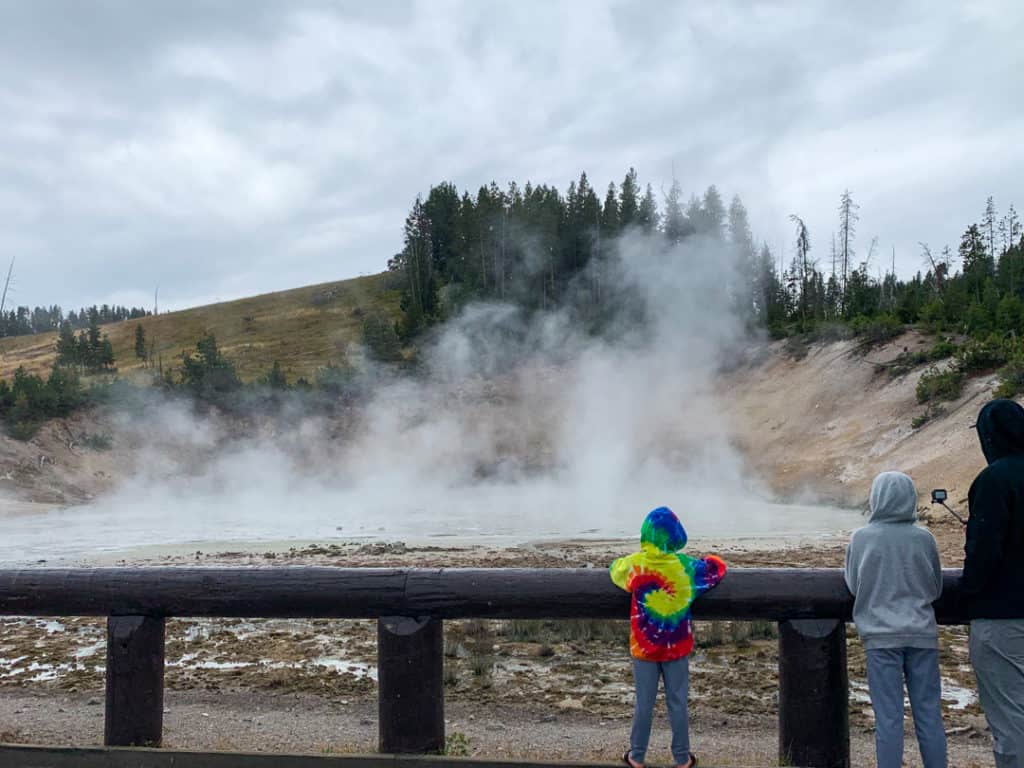
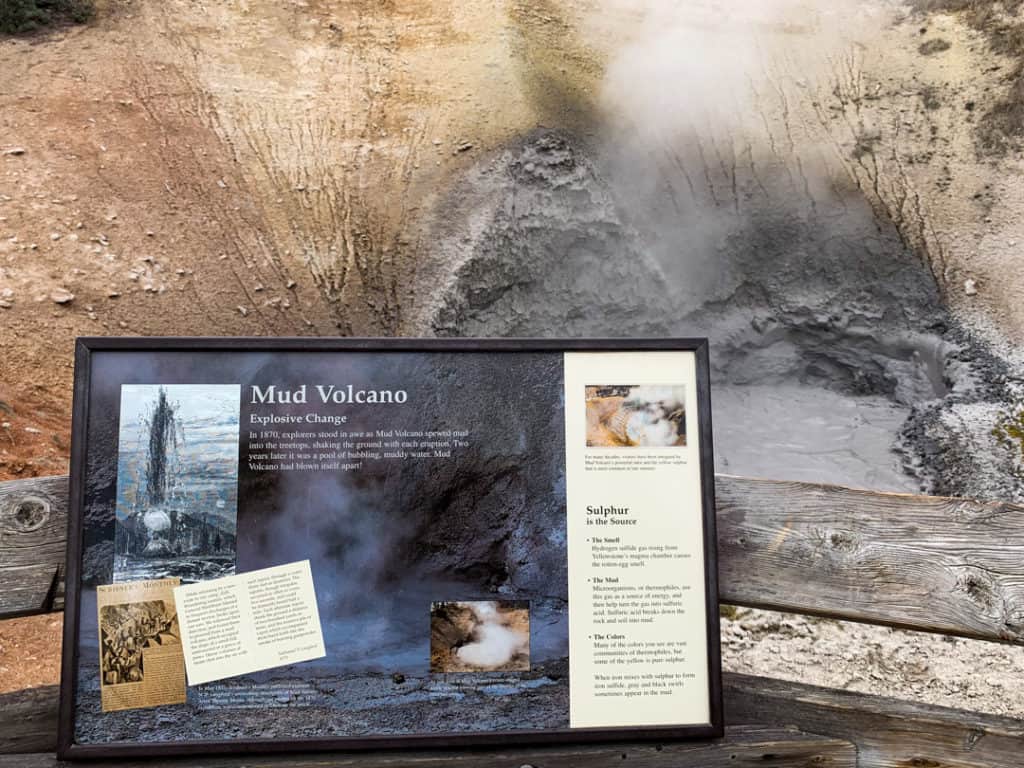
Grand Canyon of the Yellowstone
When planning your stop to the Grand Canyon of the Yellowstone, you’ll want to give yourself at least half a day to explore. But you could easily spend more!
Start by visiting the South Rim Trail to take in the views of the canyon and Upper Falls.
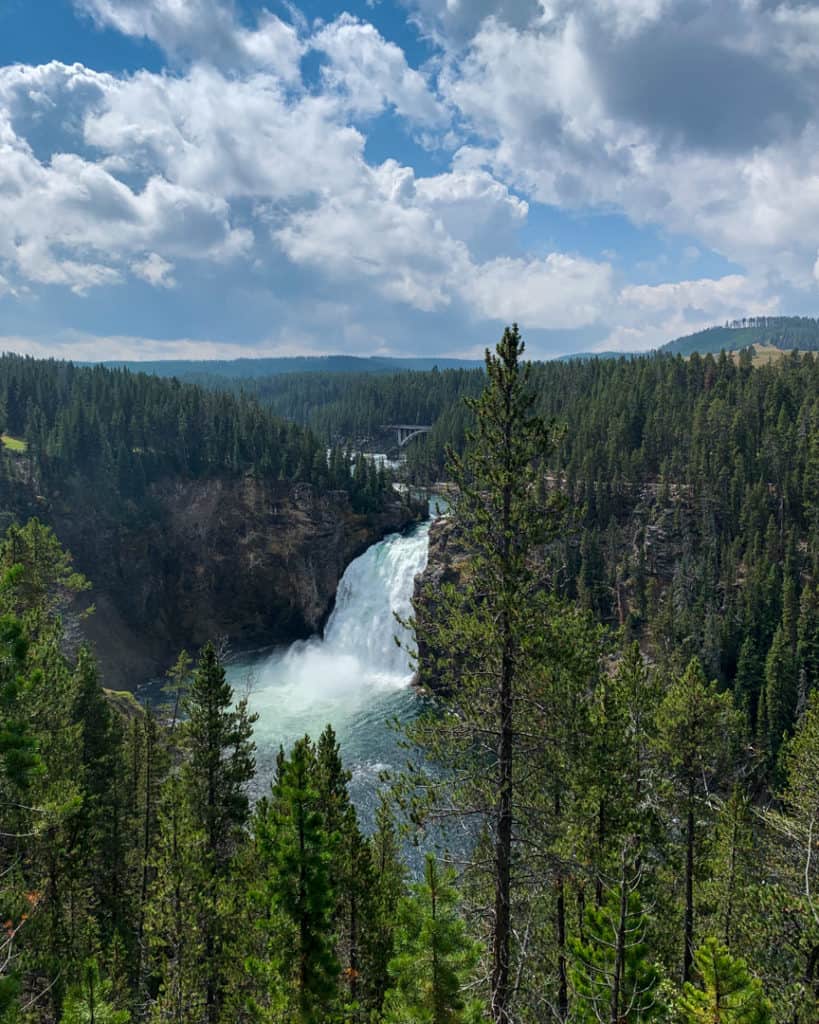
The next must-do stop is Artist Point for its iconic view of Lower Falls – though be prepared for crowds! We had to wait our turn for an unobstructed photo.
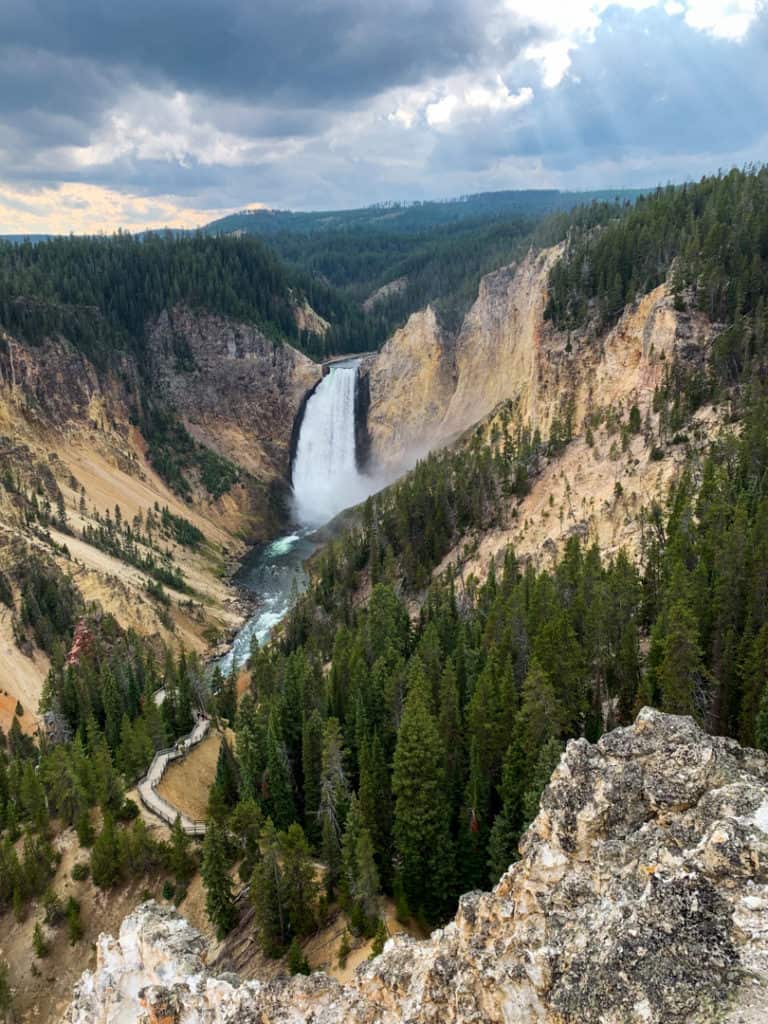
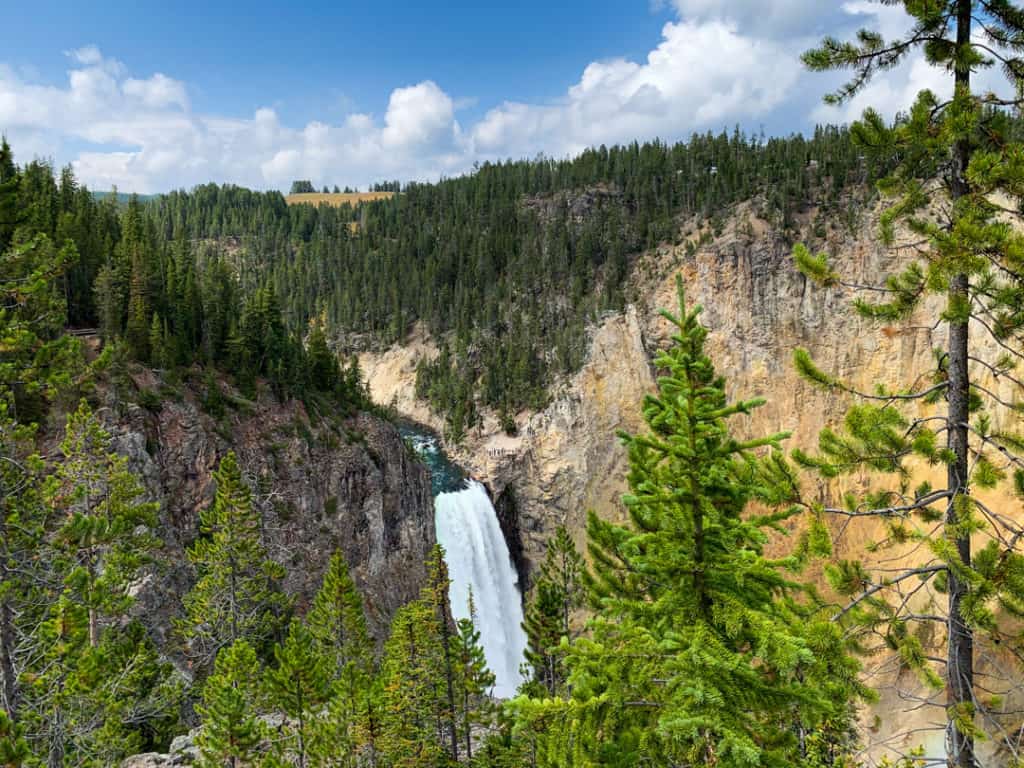
If you’re ready for a spot that’s a little more quiet, head down the trail toward Point Overlook. You can do the entire trail, but I highly recommend at least doing the first section!
Just a few minutes up the path, we found a beautiful overlook with no crowds where we could relax and take it all in.
Note: There are no guard rails here, so keep little kids close and be mindful to stay back a safe distance.
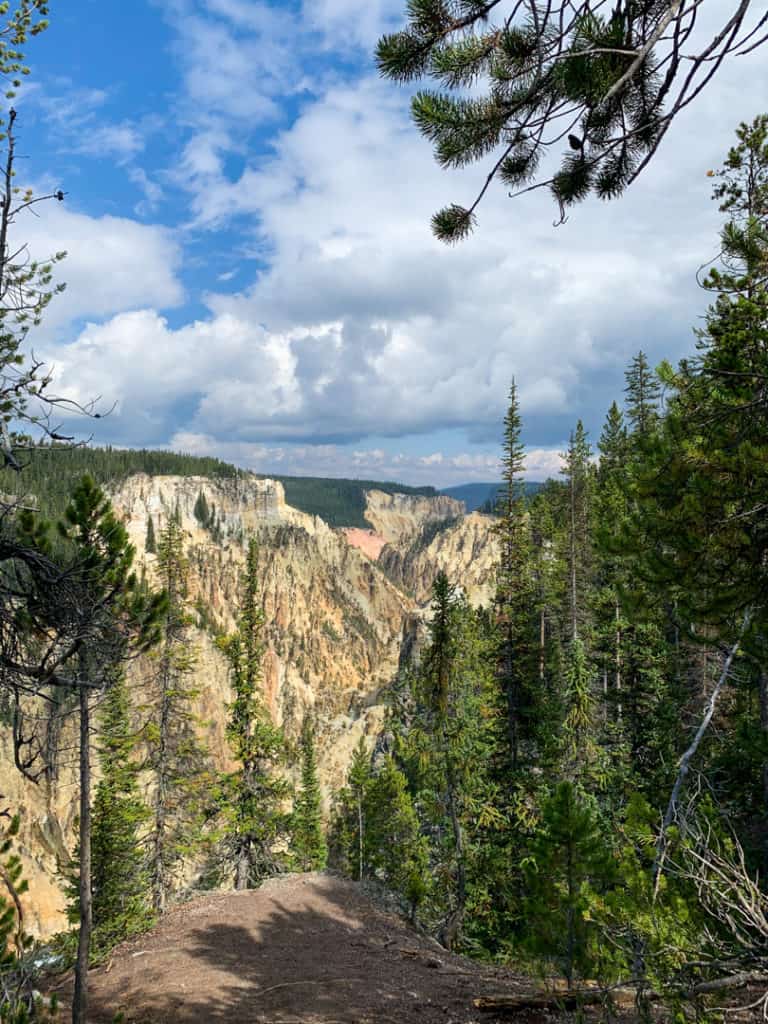
Our final stop in the Grand Canyon of the Yellowstone was Inspiration Point, where the wind added an extra layer of excitement to our visit, making for some memorable (and slightly windswept) photos that the kids loved! 😂
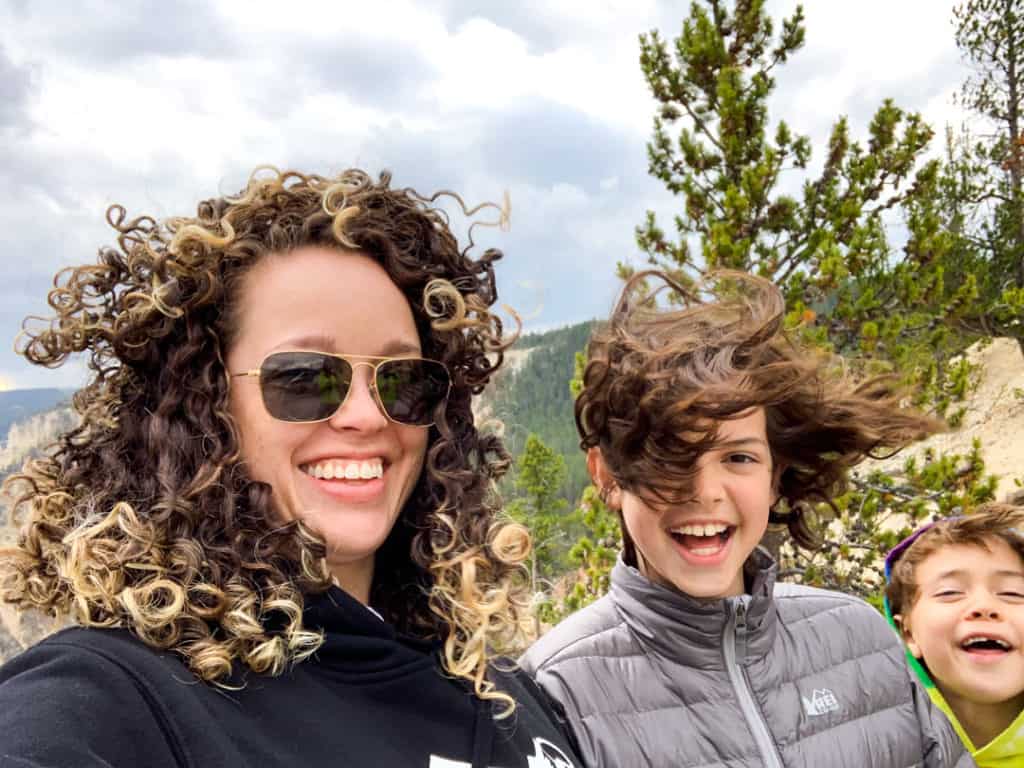
Note: Brink of the Lower Falls and Uncle Tom’s Trail were not open during our stay, but if you can add them to your visit, I hear they are amazing!
Dunraven Pass and Mount Washburn
Your chance to head back through Dunraven Pass is here! On your way back to your campground for the night, take a drive through the pass. Soak in the stunning views!
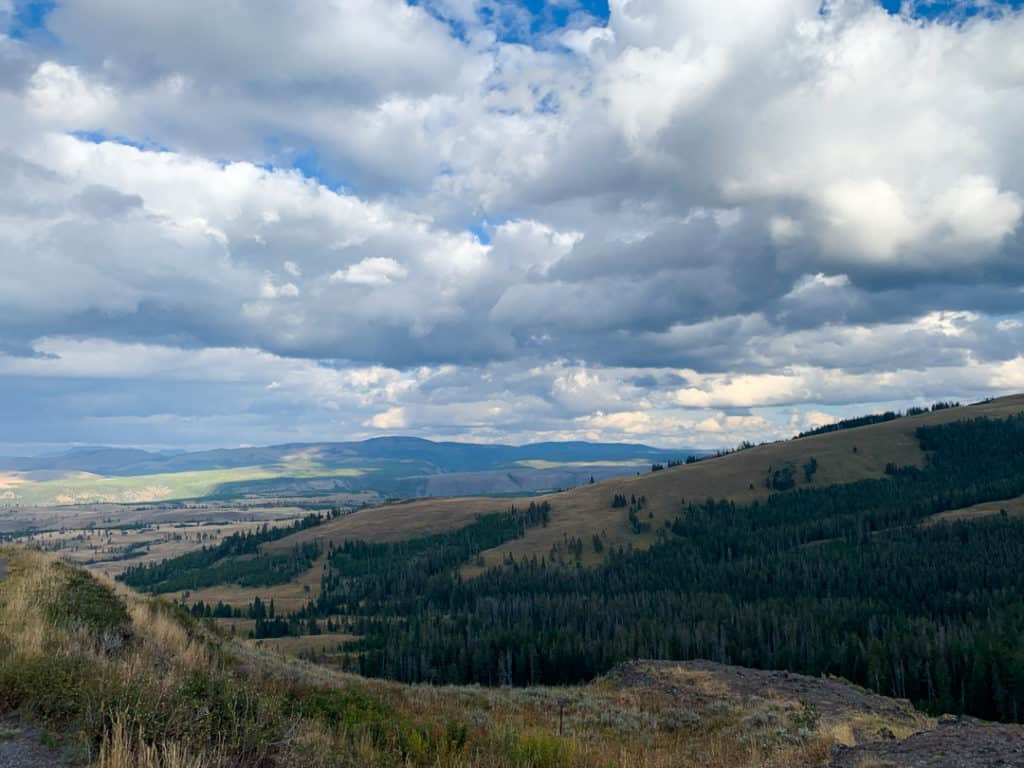
If you have enough time or want a little adventure, stop at Mt. Washburn for a hike on your way through. The trail is around 6 miles out and back, gains about 1400 feet of elevation, and offers fantastic views. In the fall, grizzly bears are often seen here looking for food, and the park recommends avoiding it in September and October.
Day 3 in Yellowstone: West Yellowstone – Geyser Basins, Geological Features, and Old Faithful
Your last day in Yellowstone is dedicated to the park’s heart and some of its most famous geothermal features. On Day 3, you’ll visit West Yellowstone, more remaining Geyser basins, and Old Faithful!
See the map overview of Day 3 here.
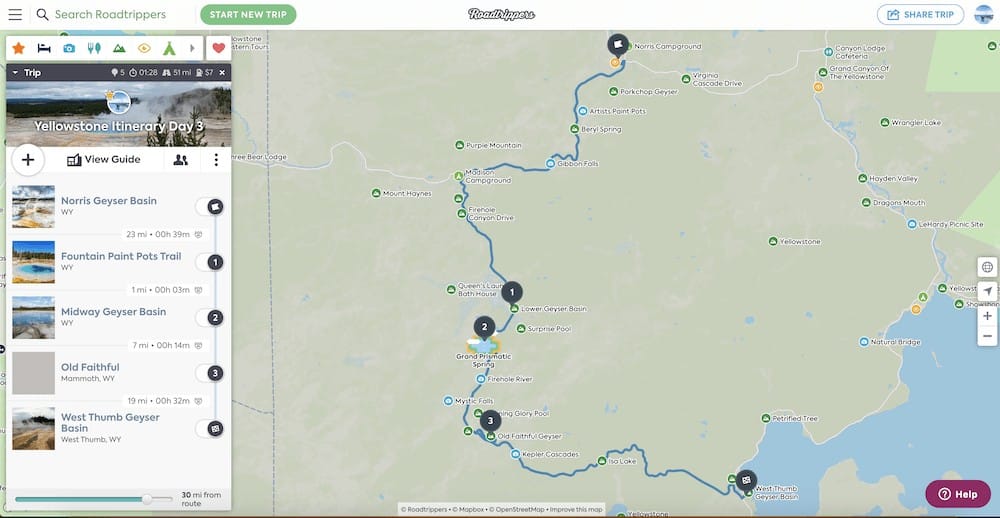
📍Get Roadtrippers Plus with $5 Off
Norris Geyser Basin
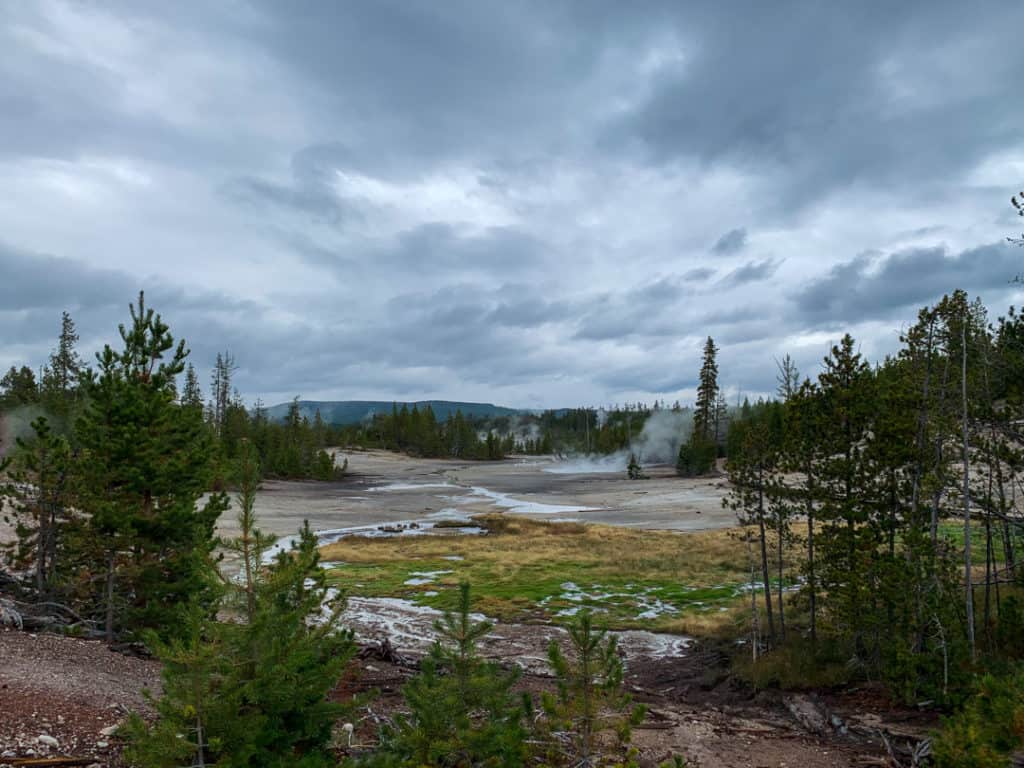
Arriving at Norris Geyser Basin, we noticed many vehicles had covers on them, which we found curious.
We uncovered the mystery shortly after arriving – Norris Geyser Basin is home to Steamboat Geyser, the world’s tallest active geyser that can shoot water up to 300 feet in the air!
The water that erupts is so acidic that it can damage paint and windshields – hence the car covers!
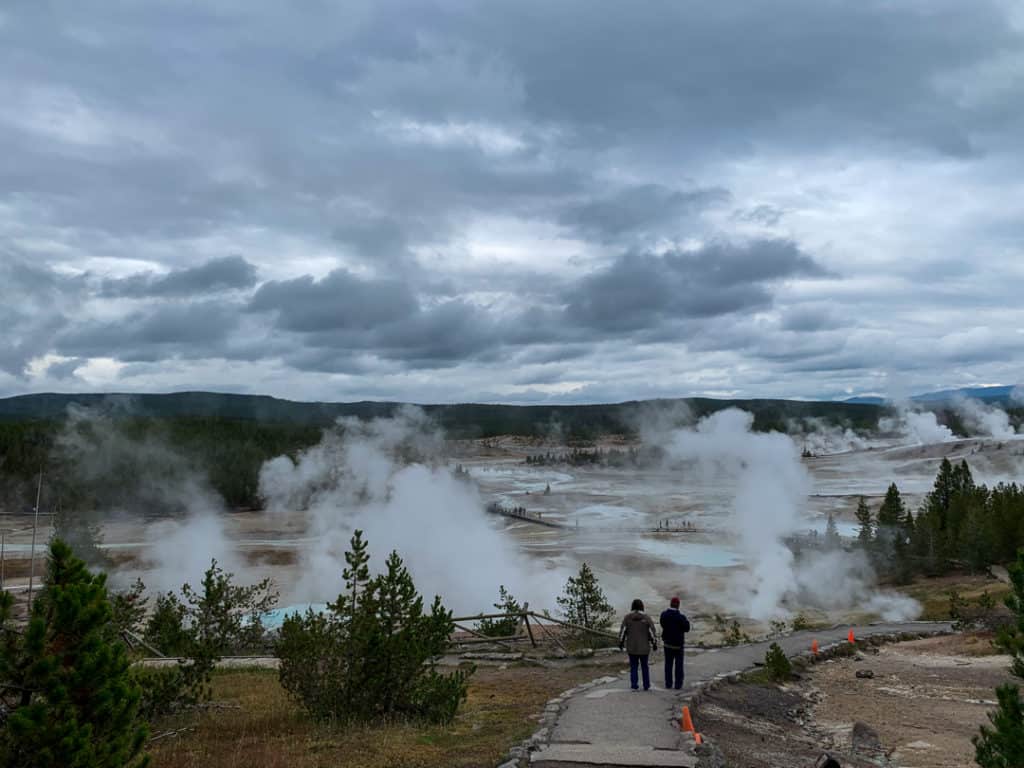
Though Steamboat is an active geyser, it’s not the easiest to predict. Eruption intervals have historically ranged from 3 days all the way up to 50 years.
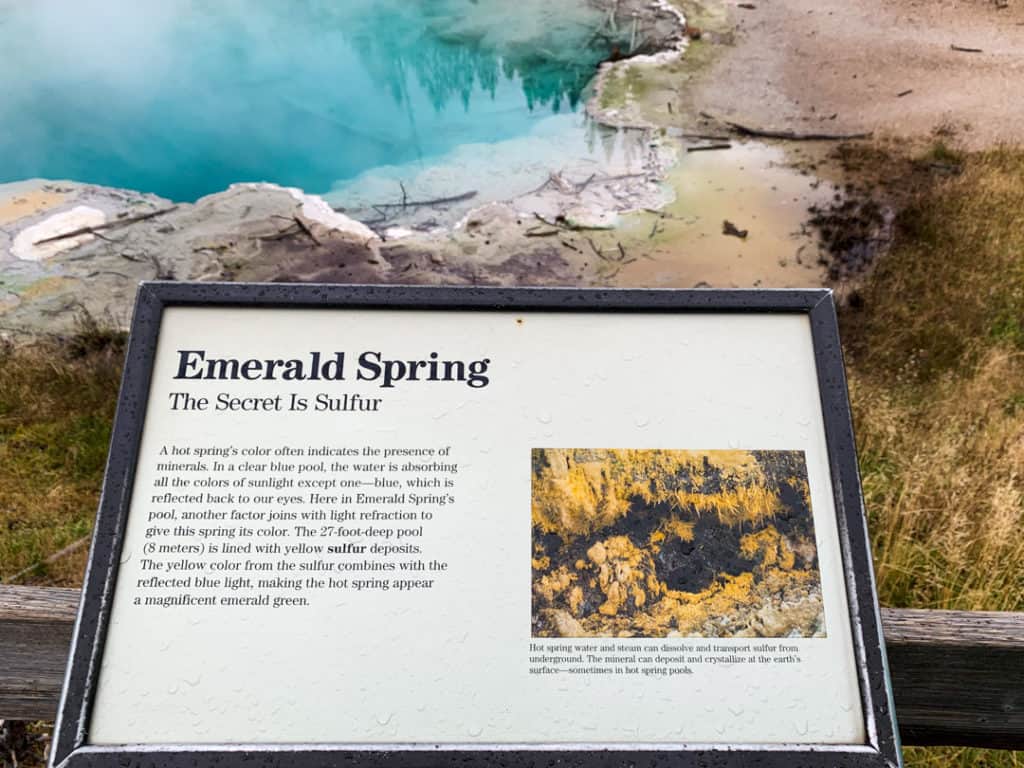
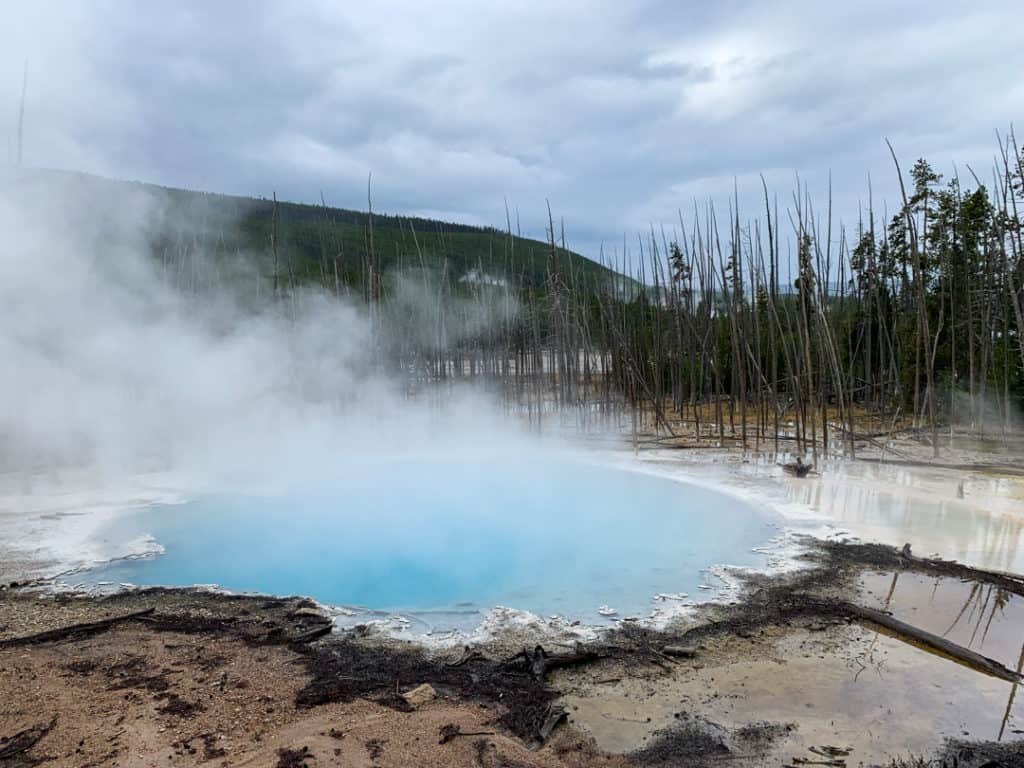
Artist Paintpot
Artist Paintpot is the one place we had planned to go to that we abandoned. 😅
Due to its popularity, the parking lot was CRAZY. We waited over 20 minutes to find parking before trying our luck at Fountain Paint Pots instead.
And, yes – we realize that people tend to wait even longer in summer.
Still, we knew that we wanted to see as much as possible with limited time, and waiting for an hour or more wasn’t the best use of our time. Next time!
Tip: When you travel, it’s extremely rare for everything to go exactly as planned. So, when you’re visiting popular places (especially with limited time), it’s essential to be flexible. We like to note which stops are non-negotiable and go with the flow on less important activities or destinations.
Fountain Paint Pots
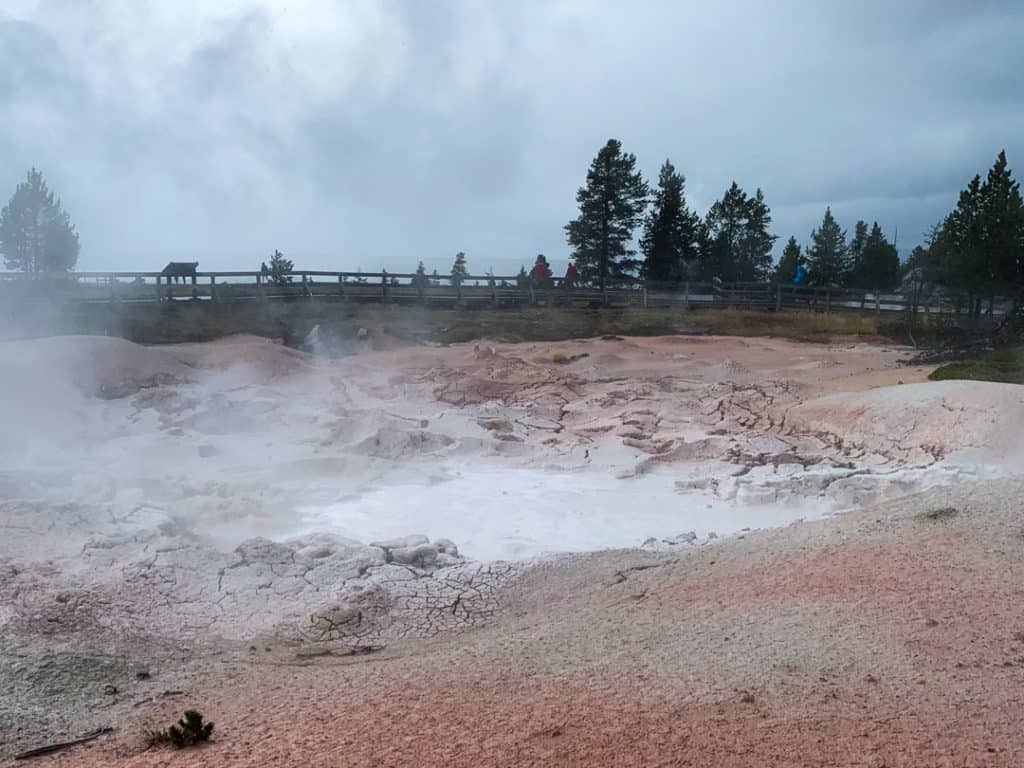
Luckily, Fountain Paint Pots welcomed us with plenty of parking and an accessible boardwalk leading us through bubbling mud pots and steaming fumaroles. It was everything our youngest had hoped for, even though we got rained – and hailed – on!
Note
This is an excellent time to mention that it’s crucial to include layers and a rain jacket in your Yellowstone packing essentials – the weather can change quickly!
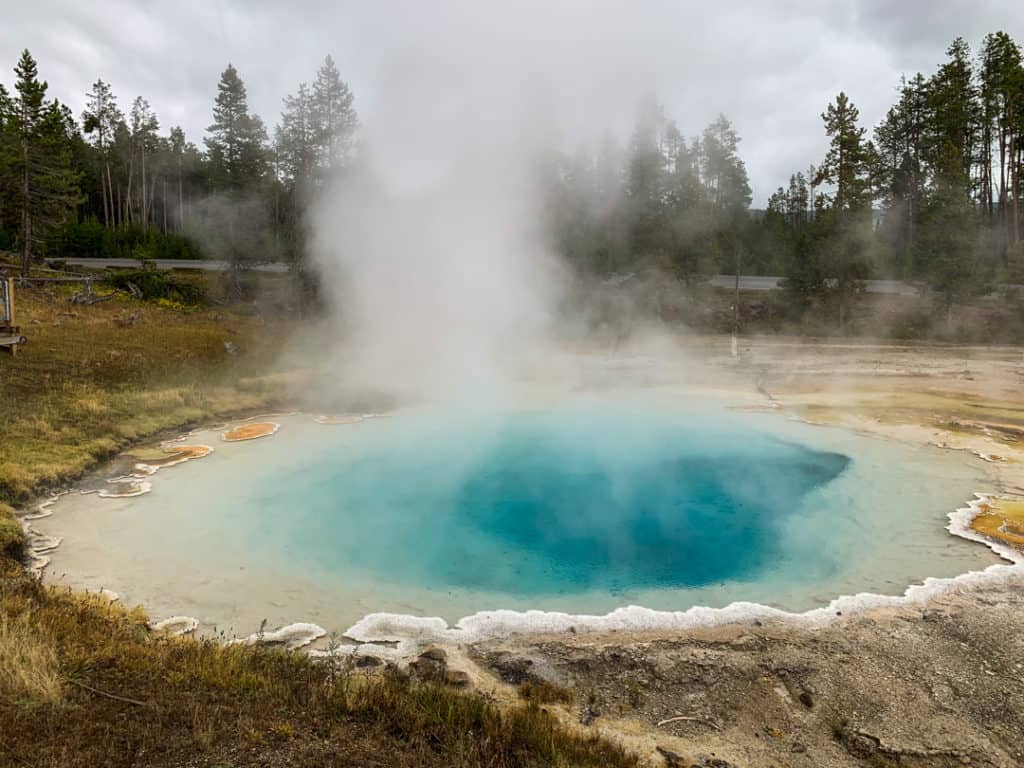
Midway Geyser Basin: Grand Prismatic Spring & Fairy Falls Trail Overlook
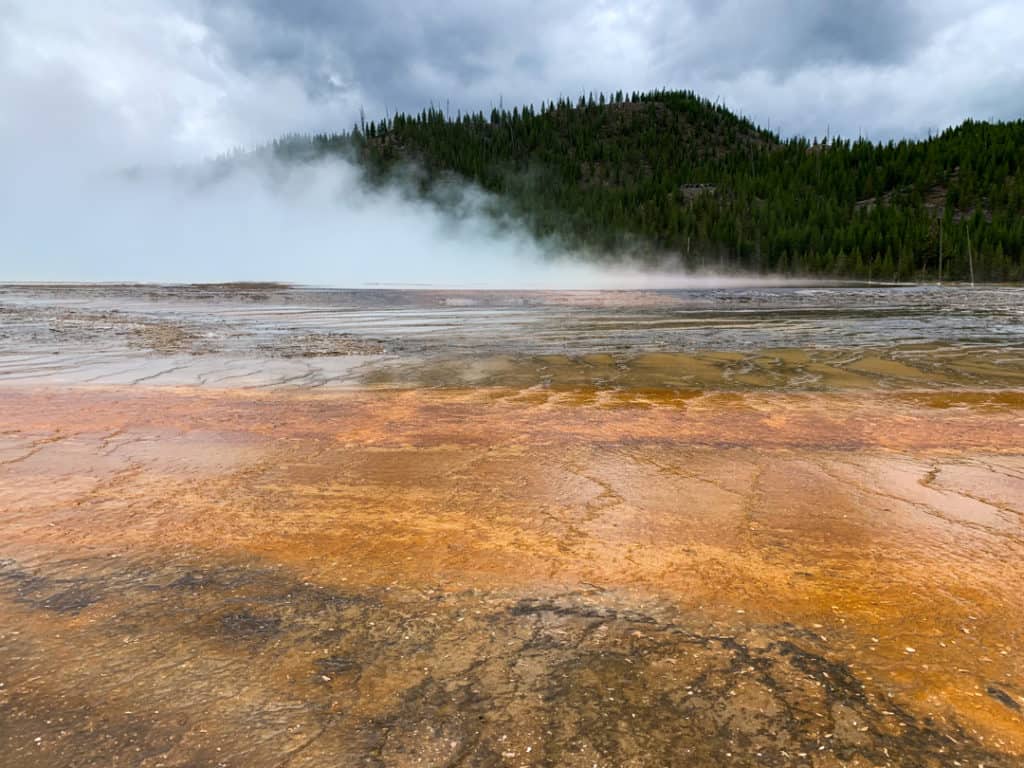
Midway Geyser Basin, with the vibrant Grand Prismatic Spring, is one of the places I was most stoked about when planning our trip.
Start your visit at the main parking area for the Grand Prismatic Spring area and spend some time strolling the boardwalk, taking in the colorful bacteria mats of the Grand Prismatic and the blue waters of Excelsior Geyser Crater.
Though we didn’t have bright, sunny skies, it was fascinating to see the hot water of the springs and geysers interact with the cold air and rain drizzle. The steam coming off them was terrific – and a bit moody – in person.
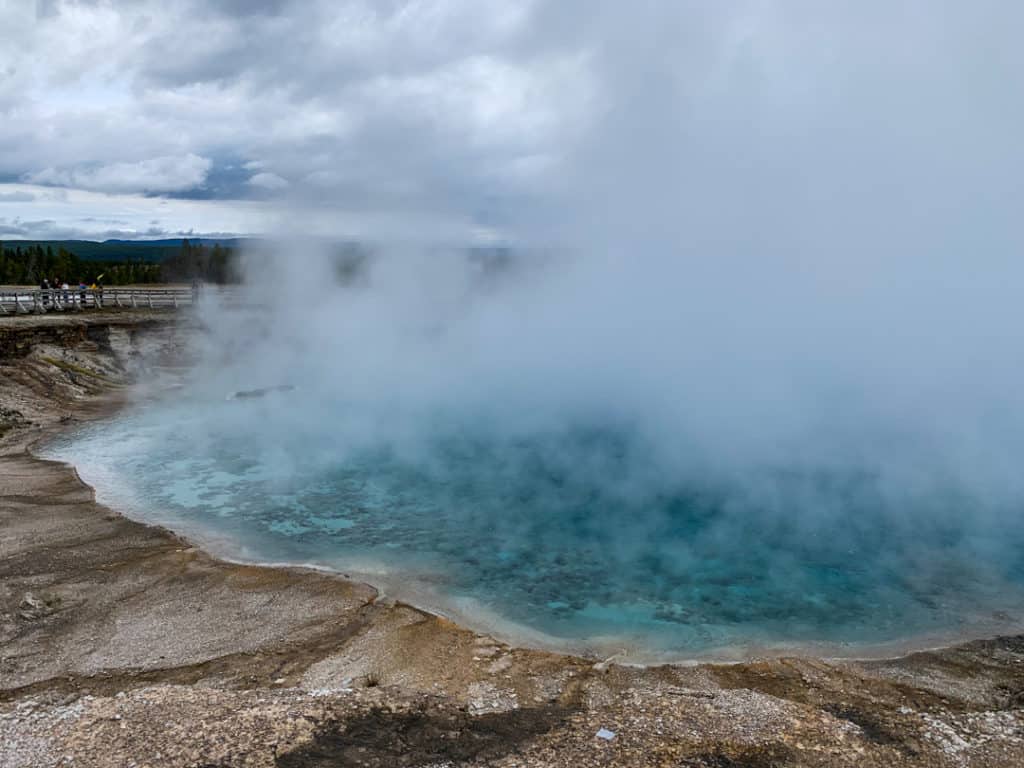
Next up is a must-do in my book – the Grand Prismatic Overlook.
Head to the Fairy Falls Trail parking area. If you have time, you can take the trail to the falls. It’s less than 5 miles out and back with minimal elevation gain.
However, if you’re short on time or stamina, the trail to the Grand Prismatic Overlook Trail is a relatively short, easy hike (1.5 miles out and back with ~200 ft of elevation gain) that is totally worth the effort.
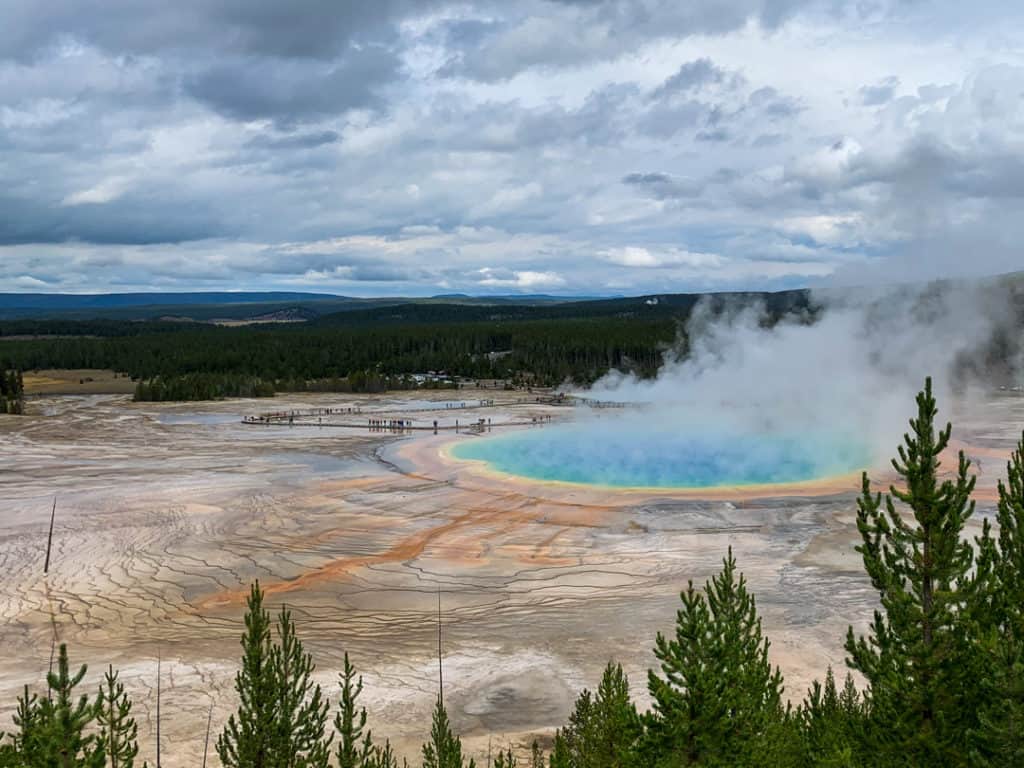
The Overlook provides a much better vantage point to see all the colors of the spring. We were so thankful that the clouds lifted just enough for us to enjoy the views!
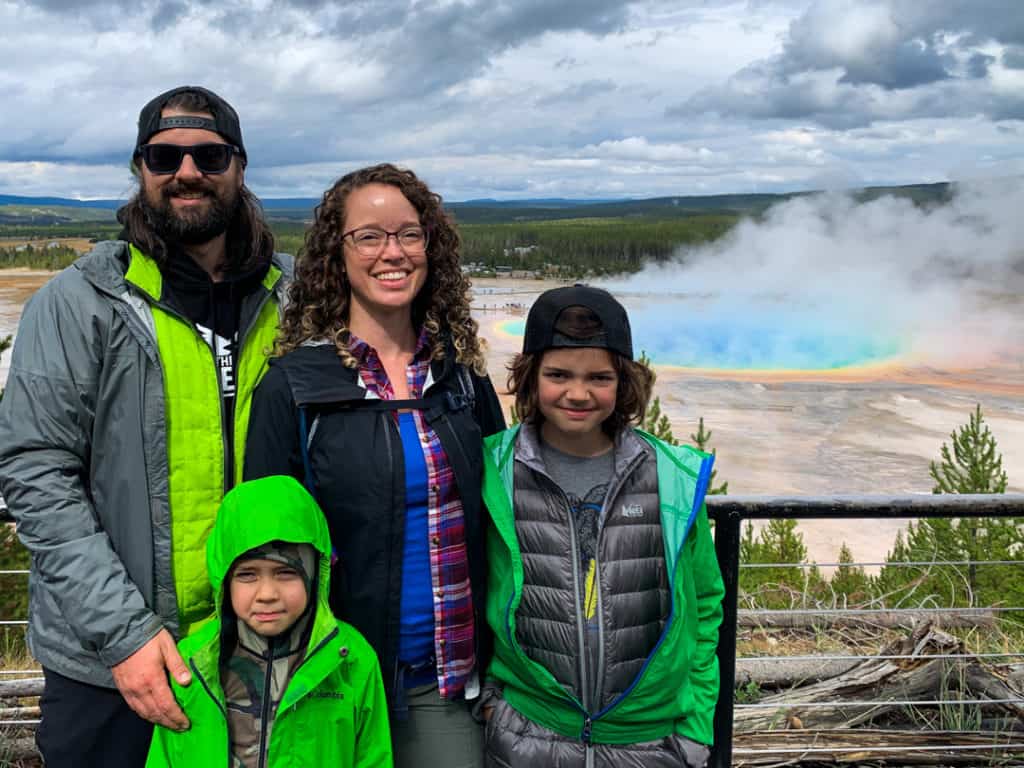
Old Faithful Geyser Area & Old Faithful Inn
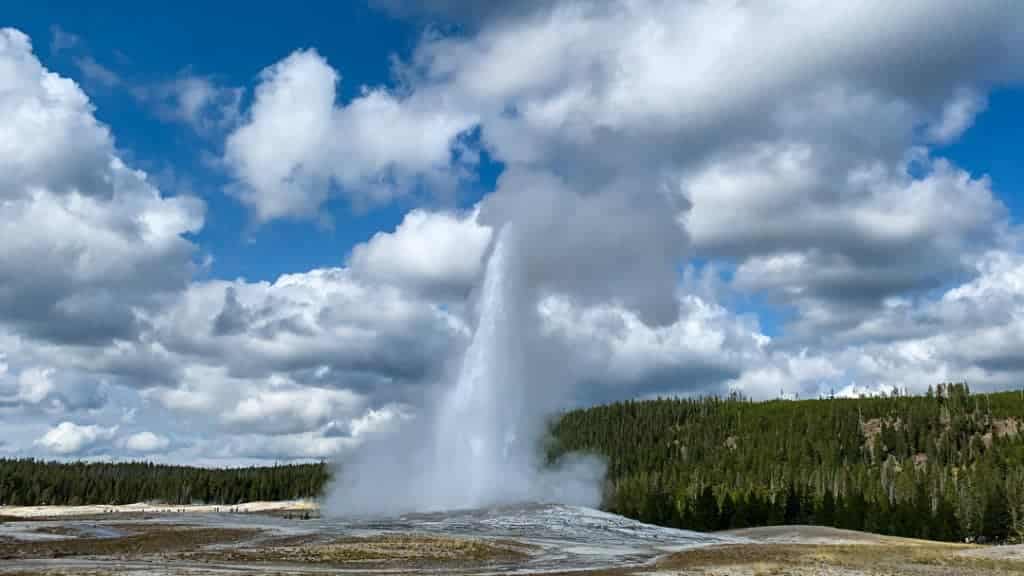
Next up on your Yellowstone 3-day itinerary is the iconic Old Faithful Geyser area.
Once you find a parking spot, the first order of business is to check the geyser predictions. I recommend checking the predictions inside the Visitors Center or via the Yellowstone app (you should have a cell signal here).
Old Faithful’s eruption schedule is relatively predictable. Although intervals can be anywhere from 35-120 minutes, predictions are around 90% accurate (with a 10-minute buffer on either side).
We got ultra lucky and only waited about 2 minutes to see it erupt, though we stuck around for one more cycle before leaving the area! It is an incredible site, and our boys still claim it’s their favorite thing in the entire park.
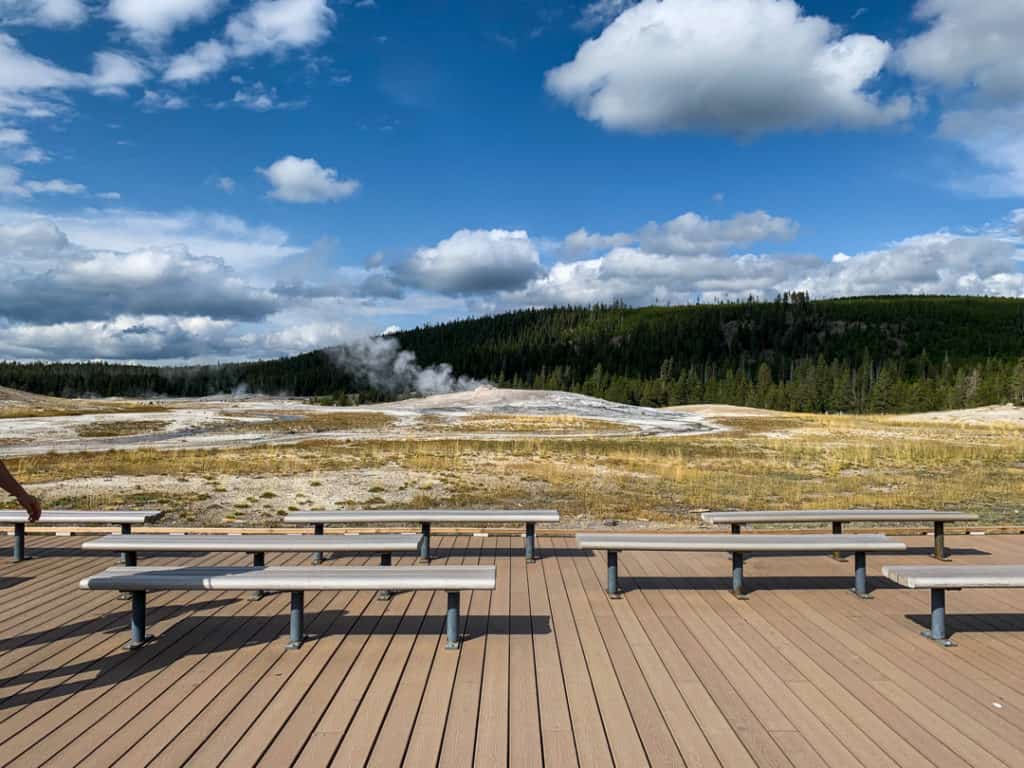
After seeing Old Faithful (or while you’re waiting), take the time to explore the other geysers in the area or head to the Visitor Center.
We headed for the Exhibit Hall to learn more about how eruptions happen and the forces that cause them. The exhibits and videos made it easy to understand, even for the kids.
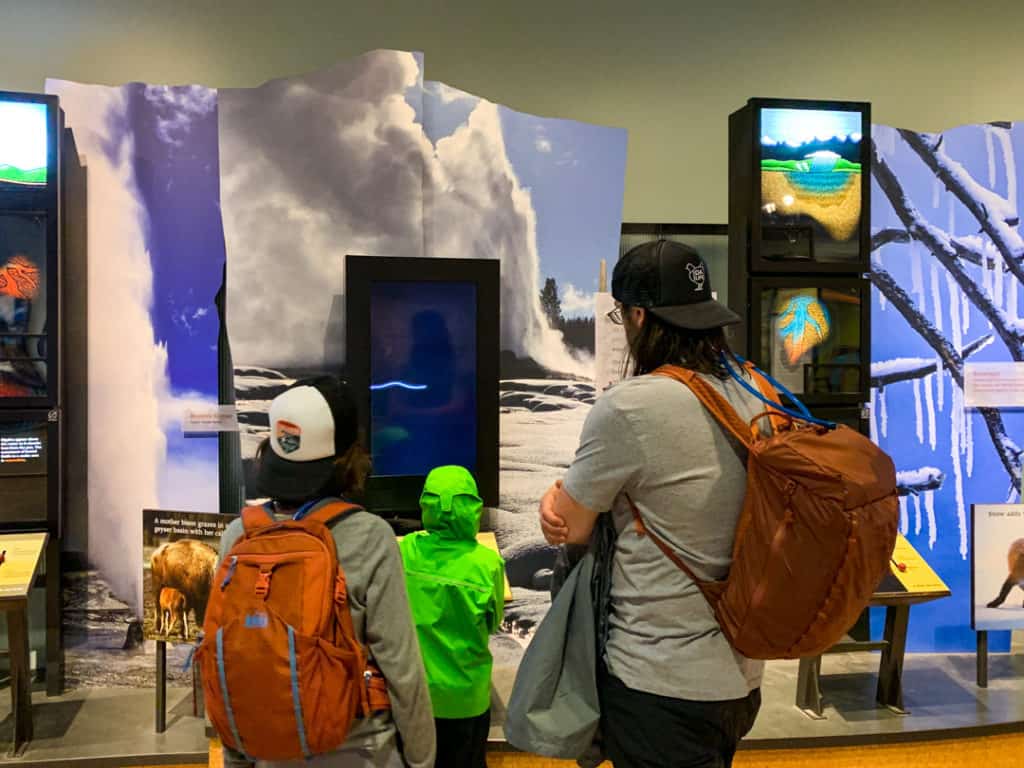
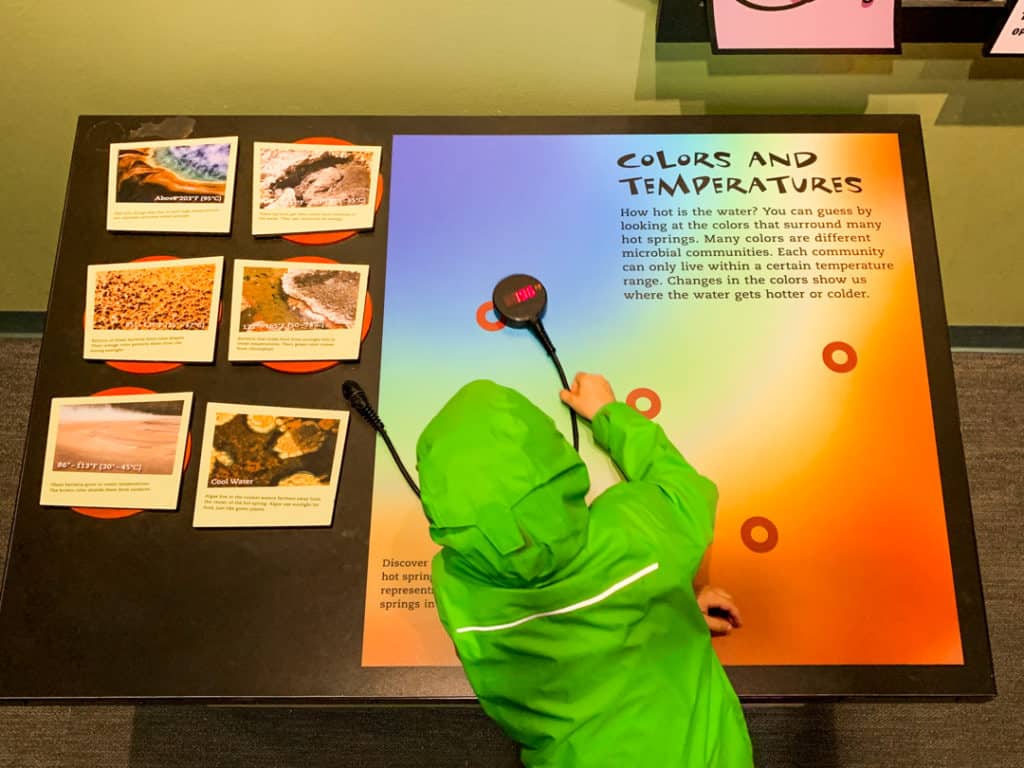
Lastly, cap off your visit to this area with a tour through the Old Faithful Inn. When you walk inside, the historic charm of this awe-inspiring log and stone building transports you back to the park’s early days.
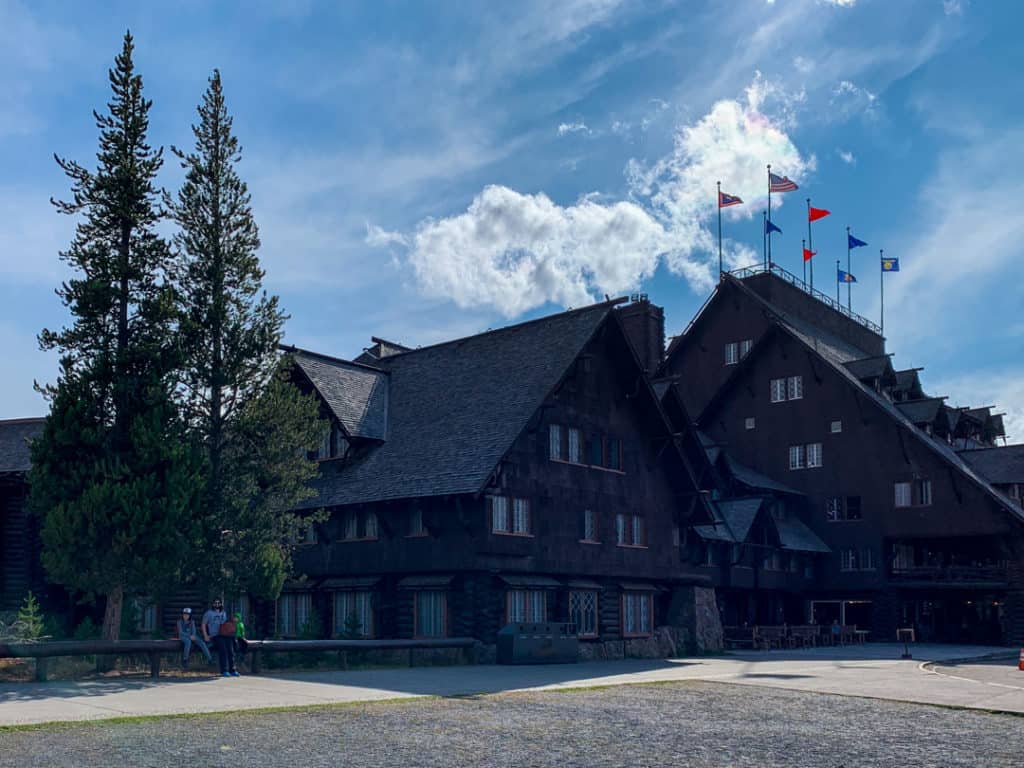
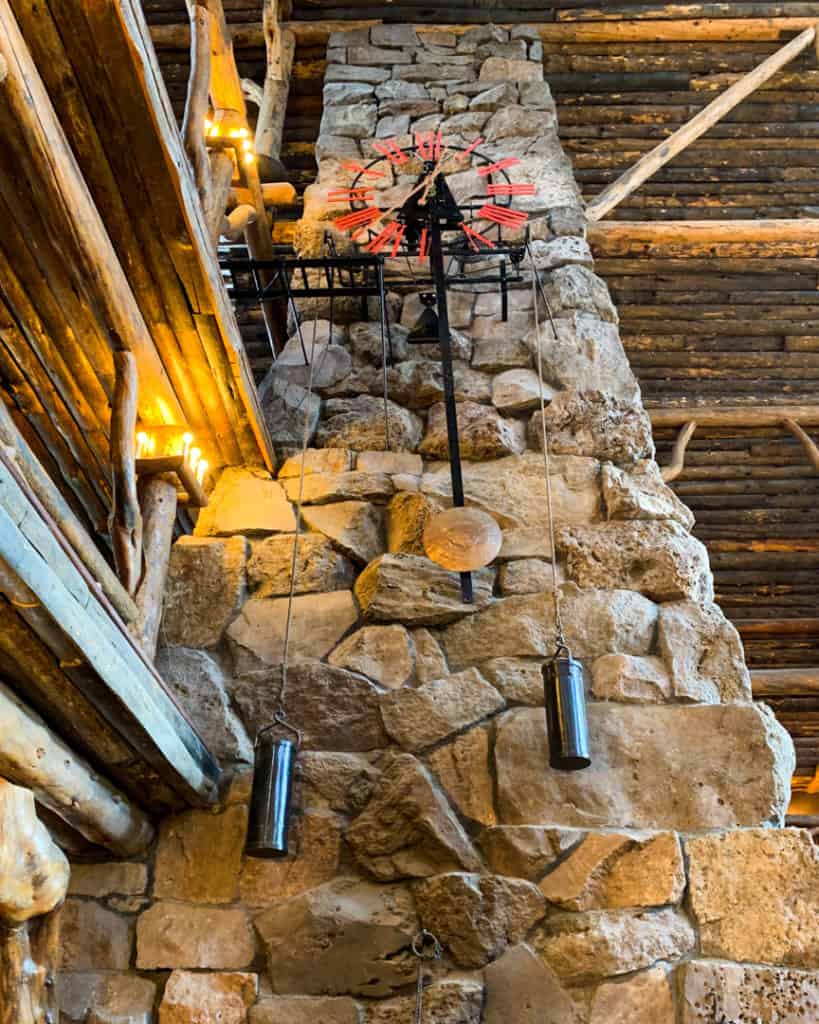
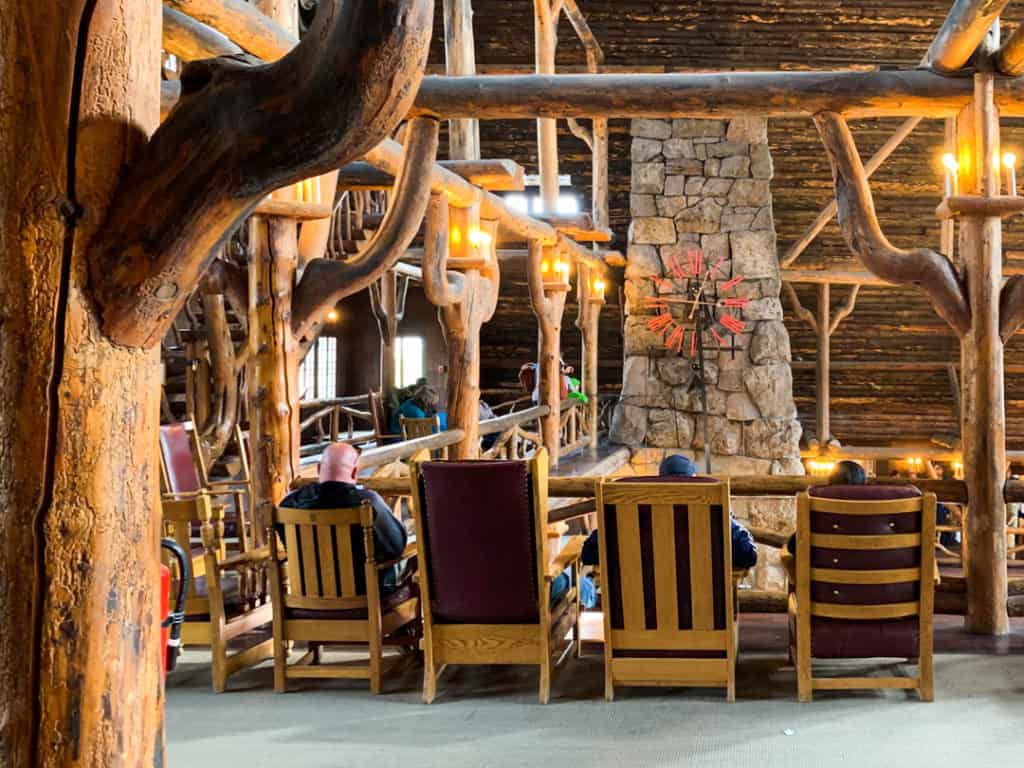
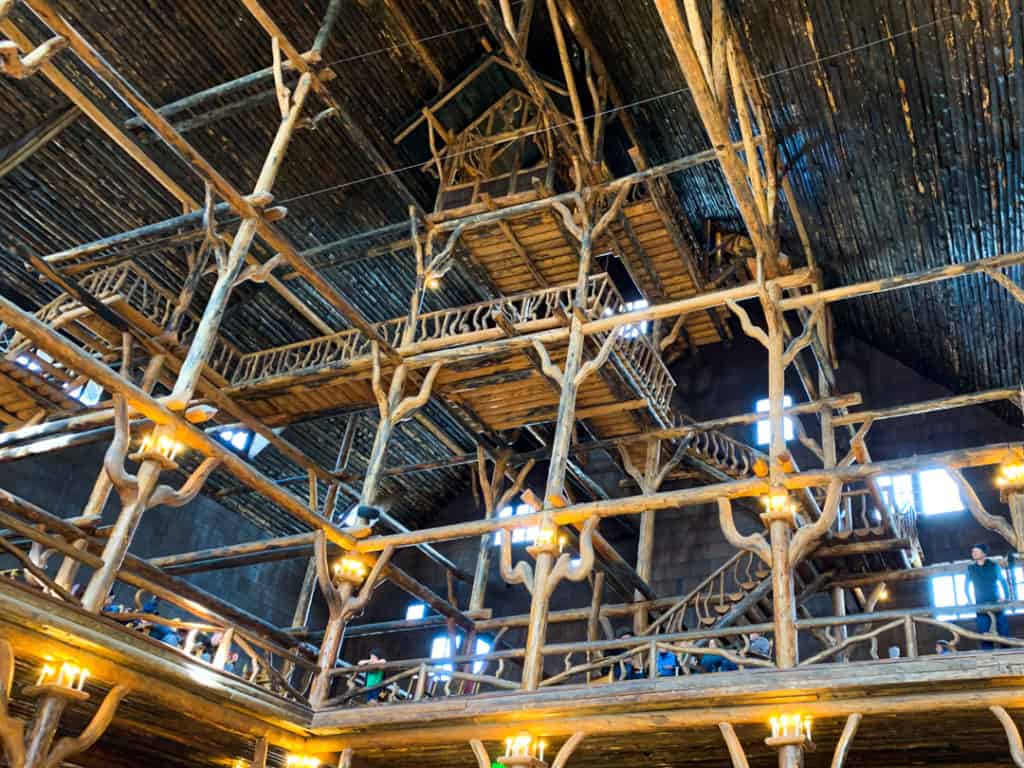
West Thumb Geyser Basin
If you can squeeze in one more stop before leaving Yellowstone, I highly recommend West Thumb Geyser Basin.
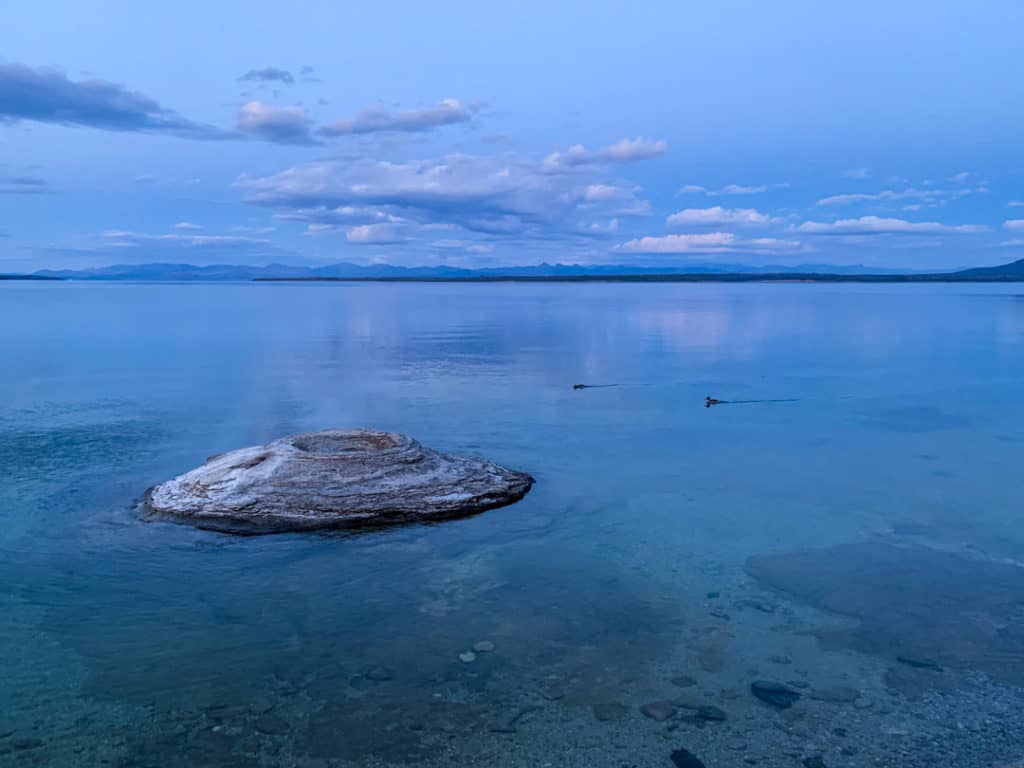
I loved visiting this spot at sunset! It was beautiful, and we got lucky and must have timed it perfectly with everyone else’s dinner – we had no crowds at all. 🙌
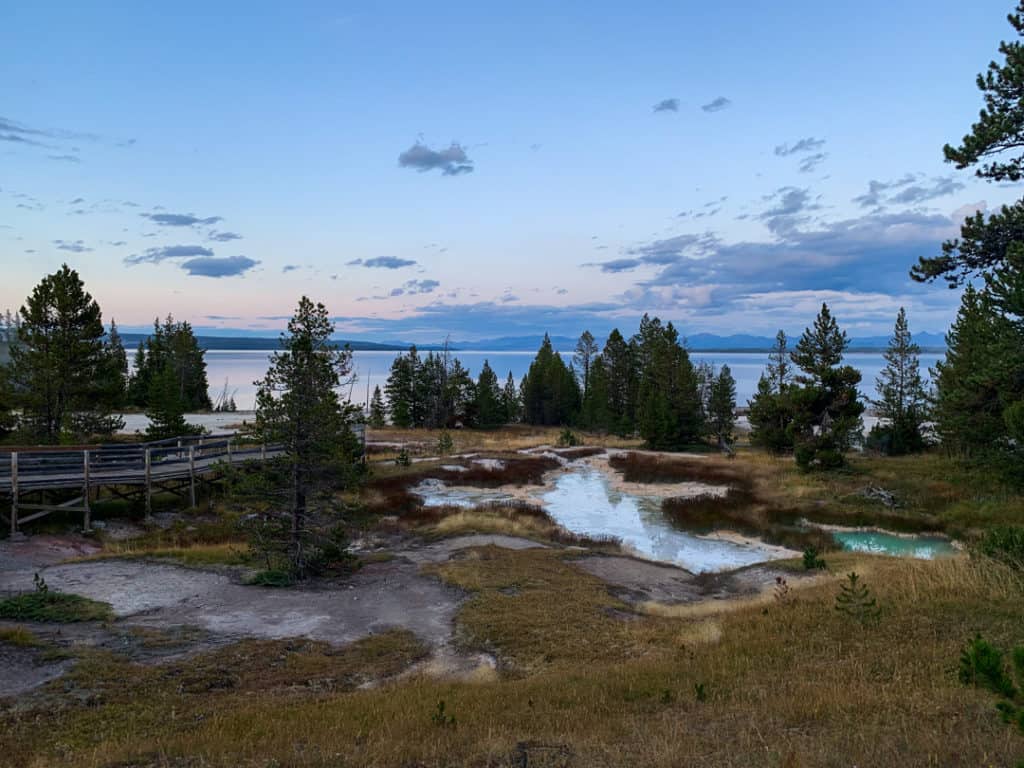
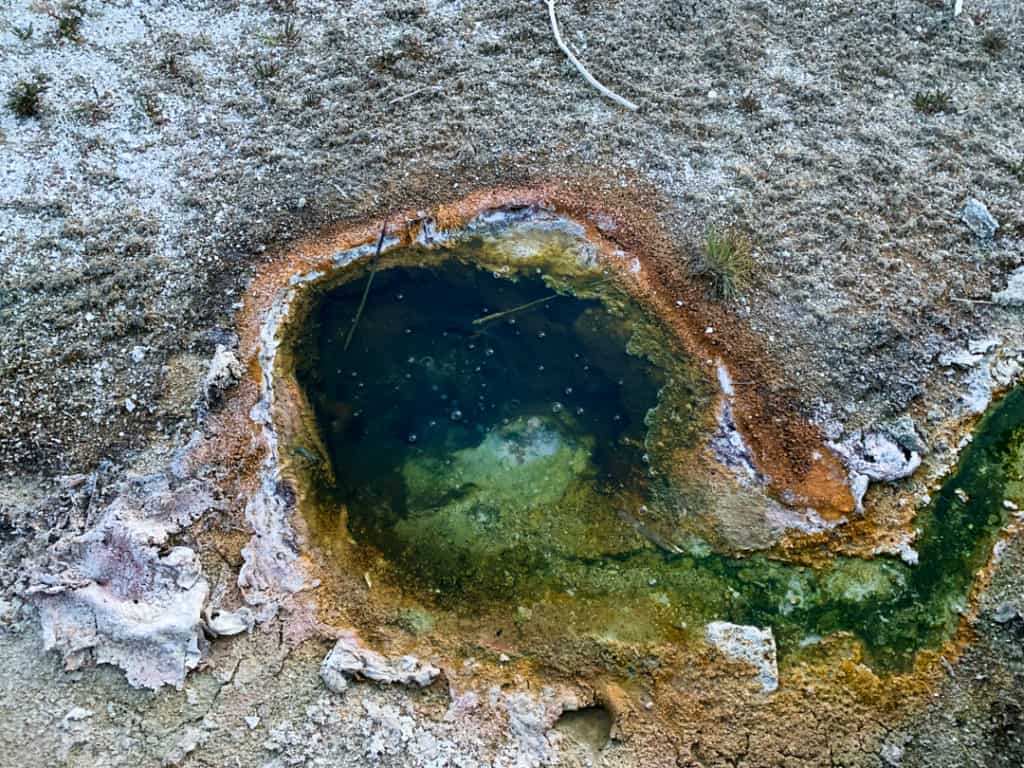
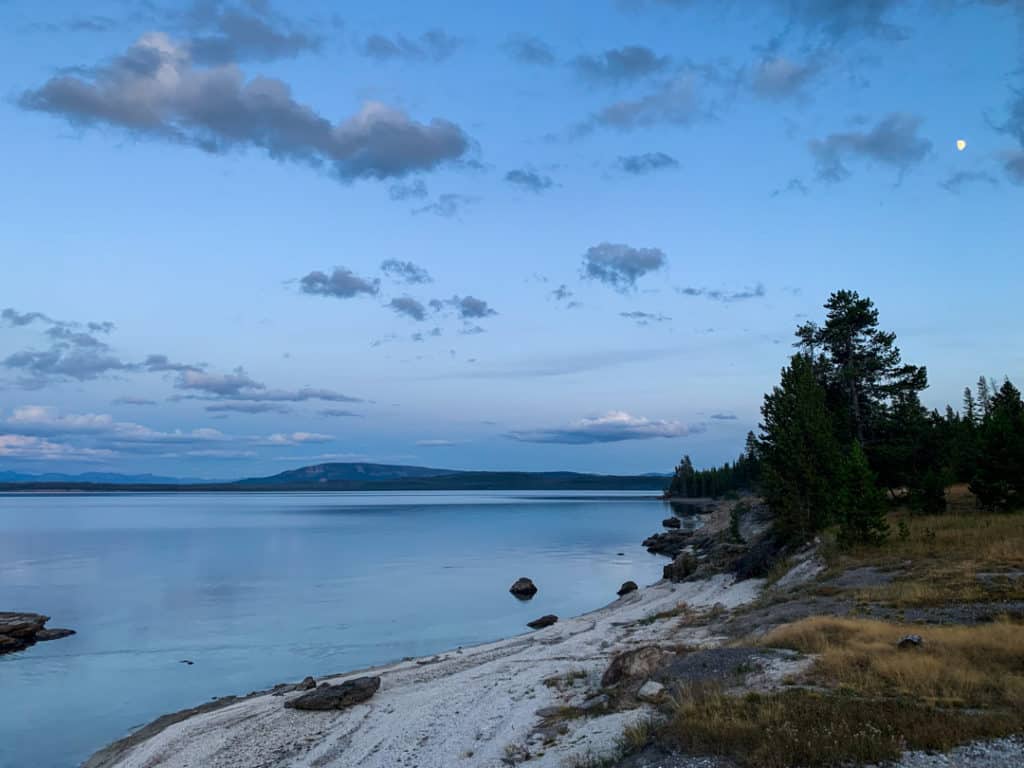
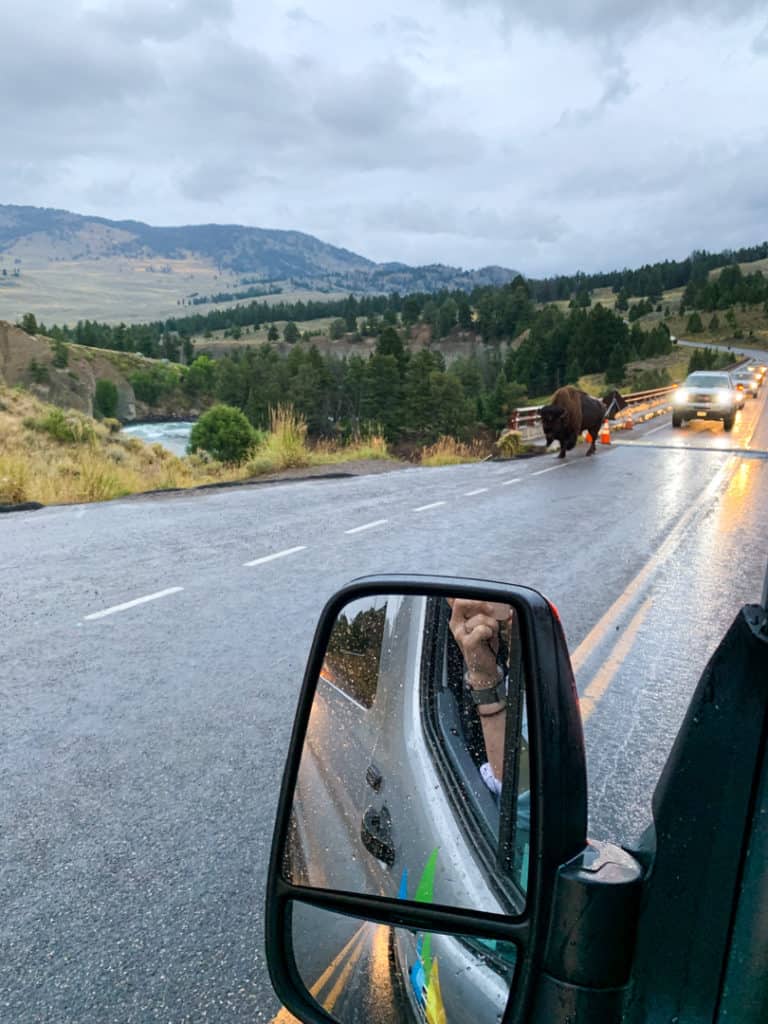
Best Apps to Download for Your Yellowstone Trip
- GuideAlong is an audio tour that you pick up wherever you start your day. It automatically plays as you drive through the park. Plus, it works like magic, even when you don’t have a cell signal. (They use satellites, but magic sounds more fun.😉) We learned so much more about the park’s history and different geological features that we would have missed without this app. “Secret school” for the win!
- Roadtrippers is a road trip planning app that lays out the order that makes the most sense to minimize your drive time. They have both a free and a paid Plus version. The biggest perks to the Plus version, is that it lets you plan longer trips, share with friends, and access maps offline…this is super beneficial when we were in the park as service is very limited. If you like the map and Yellowstone 3 day itinerary we created on Roadtrippers, you can use code: STOKEFAM for $5 off a year of the Plus plan! Click here to learn more about how to use Roadtrippers
- The Yellowstone National Park App is especially beneficial for info about a particular area, road closure details, schedules, and more. The thing we used the most is the live Geyser Prediction. When you are in a service area (the main campground areas, Old Faithful, etc.), you can pull up predictions to help you plan your day.
Wish Someone Would Just Plan Your Yellowstone Trip For You?
No worries! We’ve got you.
Grab a copy of our Yellowstone National Park Trip Guide & Planner and take the stress out of all the planning!
Yellowstone National Park Trip Guide & Planner
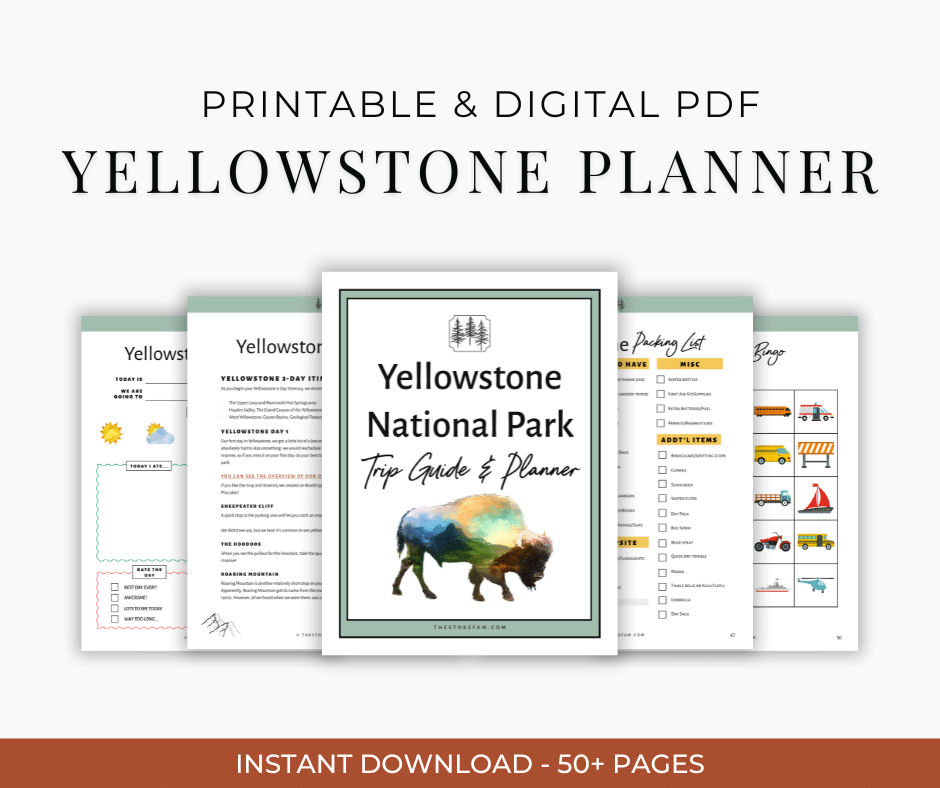
Make planning easy with my detailed Yellowstone National Park Trip Guide & Planner!
FAQs About Visiting Yellowstone
Is 3 days enough at Yellowstone?
Three days in Yellowstone is enough to get a great overview of the park and see all the main features. However, you could easily spend a week or more exploring, particularly if you plan to spend a lot of time hiking or getting off the beaten path.
How many days are recommended to see Yellowstone?
You’ll need at least 3 days in Yellowstone to see the main attractions. However, if you can spend 5-7 days (or more), will make you feel less rushed and have more time to explore beyond the most popular attractions.
What is the best way to tour Yellowstone?
We think the best way to tour Yellowstone is in a small, drivable RV such as a campervan or truck camper. This way you only have to pack once and can easily move from site to site, minimizing your drive time and covering more ground. Plus, this makes having meals anywhere you like in the park easier!
Can you do Glacier National Park and Yellowstone in the same trip?
Yes, you can do Glacier National Park and Yellowstone in the same trip. They are about 6 hours apart, so you’ll need to plan in additional time for the drive, plus time to explore Glacier. If you’re a little crunched for time, but still want to see another National Park, try Grand Teton instead (1-2 hours away).
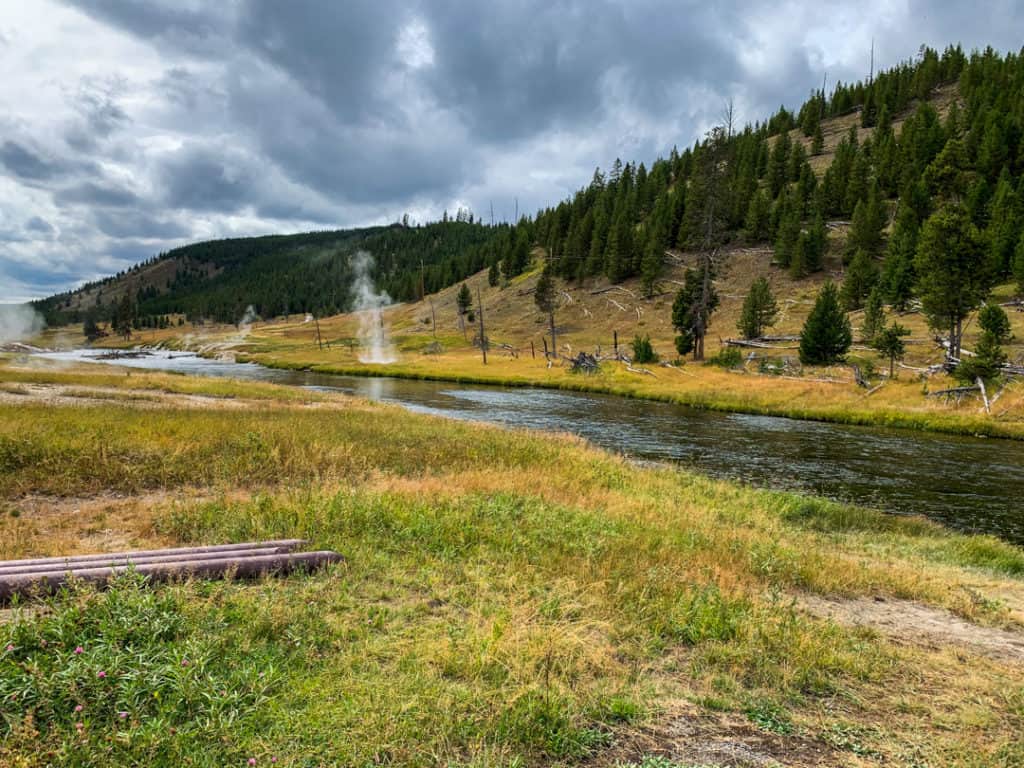
Final Thoughts About the Best Yellowstone 3 Day Itinerary
Yellowstone National Park is an incredible destination with a ton of things to do. But with so many options, it can be hard to narrow it down.
In this 3-day travel guide for exploring Yellowstone National Park, you’ve got plenty of ideas for how to plan your visit to make the most of seeing the abundant wildlife and geological features it offers.
Yellowstone is massive, so you could easily spend a few weeks and never run out of things to explore. But, when you only have a few days, you’ll want to hit the highlights you can’t miss.
This Yellowstone National Park itinerary gives you the key things you need to see and do for an unforgettable vacation – bookmark it to come back to as you finalize your trip details!
Or grab a printable copy of this itinerary and more helpful planning tips in my Yellowstone Trip Guide & Planner.
More Yellowstone Planning Tips 👇
- Getting Started: Planning a Trip to Yellowstone: A First-Timer’s Guide
- Where to Stay: Where to Stay in (and Near) Yellowstone
- What to Do: 23 Awesome Things to Do in Yellowstone (Detailed Guide & Map)
- Itinerary Suggestions: The Perfect Yellowstone 3-day Itinerary to See the Most
- Tips for Visiting: Visiting Yellowstone: 23 Essential Tips & Things to Know
- What to Pack: Yellowstone Packing List: What You Need (and What You Don’t)

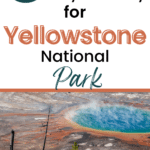
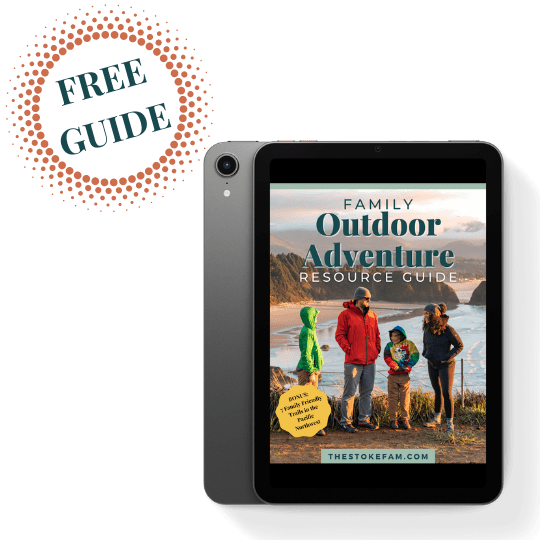
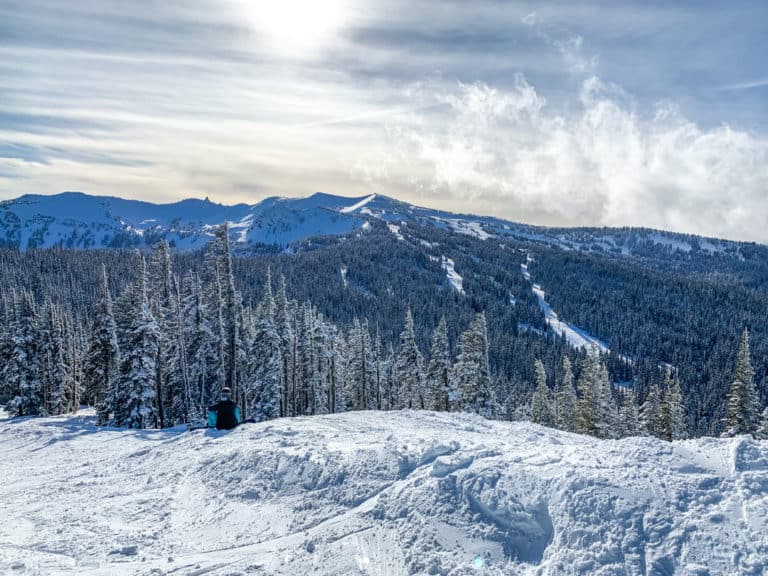

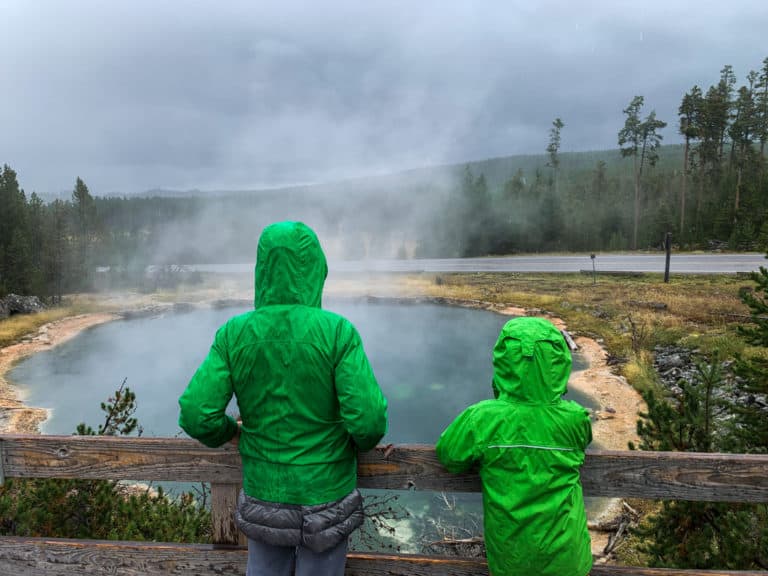
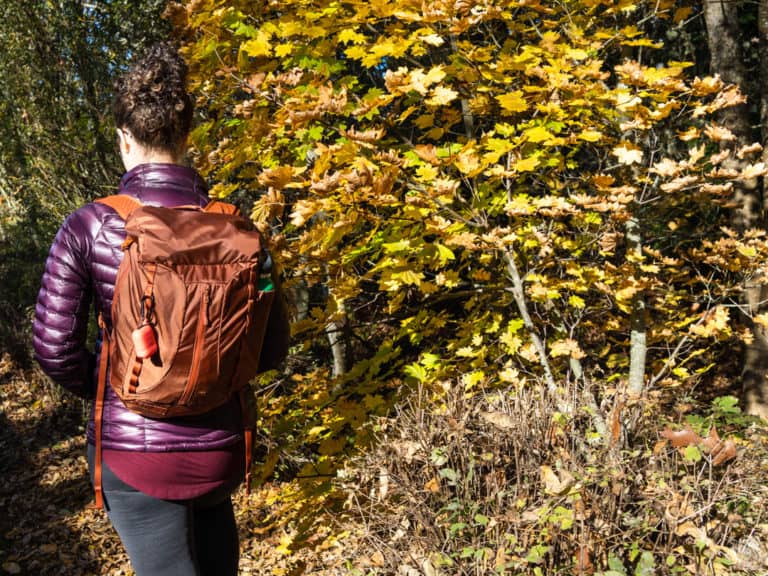
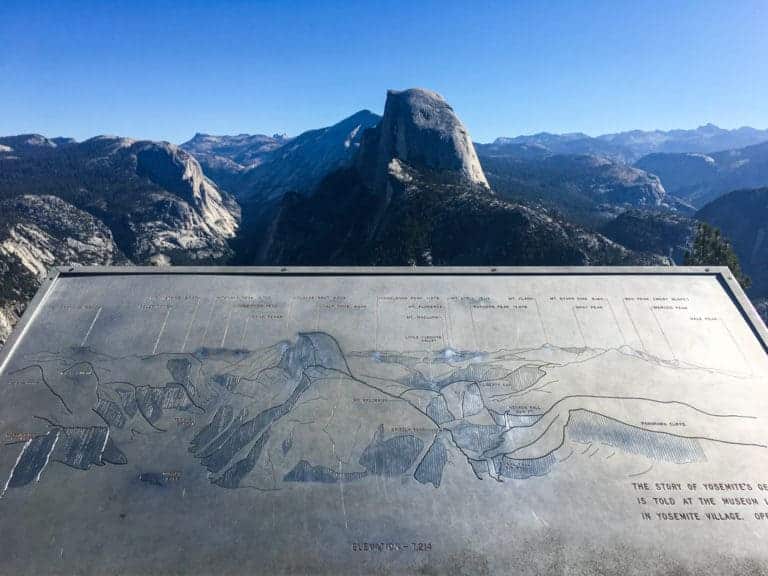
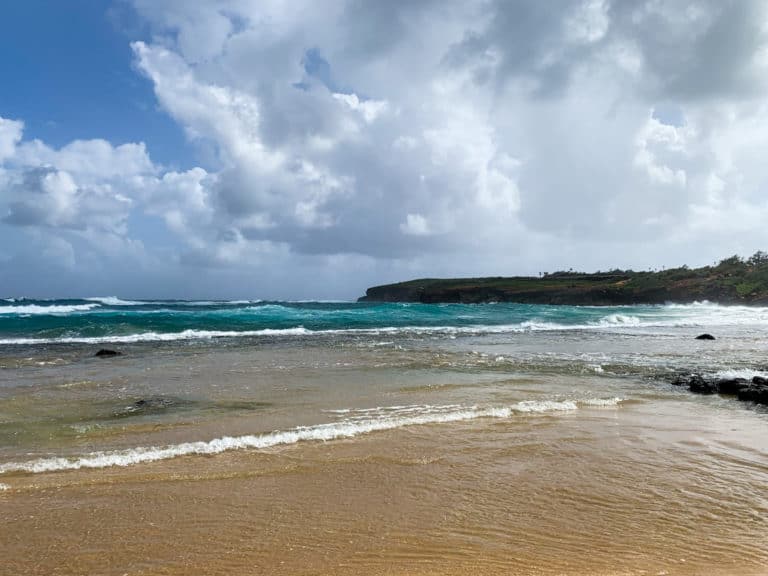
This Yellowstone 3-Day Itinerary is incredibly helpful. You’ve really thought through everything you need to know before planning a trip. Thank you for this helpful resource. Saving this guide for later!
You’re so welcome! Are you planning a trip to Yellowstone soon?
Thanks for the great information for us.
Best regards,
Dinesen Duke
I’m so glad you found it helpful!
This itinerary would be perfect for our family – and I had NO IDEA that you can rent campervans! I’ll have to check in to if they can accommodate sleeping 5? Anyhow, awesome article! I will definitely be referring back to it!
Yes! It’s so cool! We want our own now! I’ve seen configurations for 5, but I don’t know about in rentals. Although, a small kiddo could totally have slept on the bench seat in the one we were in.
This is a great itinerary for exploring Yellowstone and the Old Faithful Inn looks amazing! Definitely saved this one for later.
Old Faithful Inn was truly magical. I LOVED it!
So much to see and do in Yellowstone for three days or even longer! We were there for 2 and I wished I had planned for more!
I think it would be easy to spend even a week or two! But, I did feel that with three days we got a good overview and feel for the park so we know what we want to focus on the next time we visit.
This looks incredible! We so want to visit Yellowstone! I am saving this for the future!
It’s great! And, so interesting for kids too!
This bought back great memories from our time in Yellowstone. Will definitely go back!
We will too! It was definitely an incredible experience!